
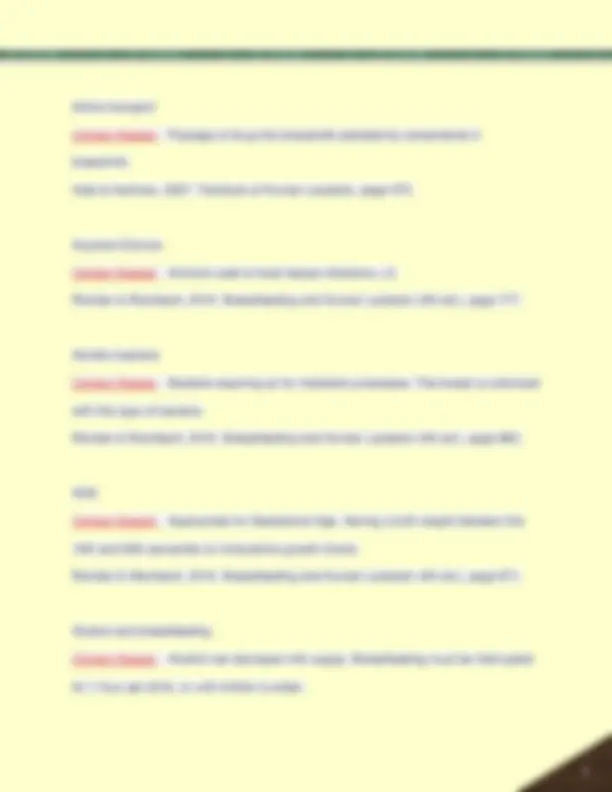
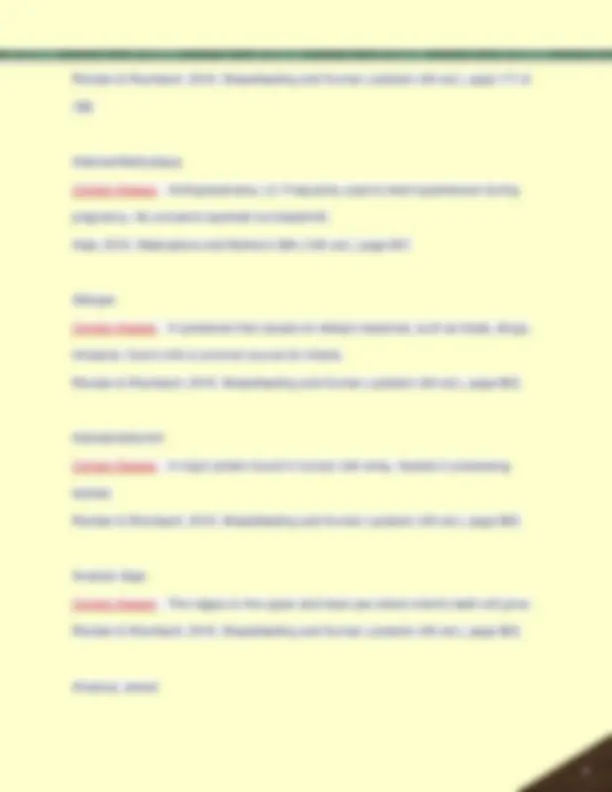
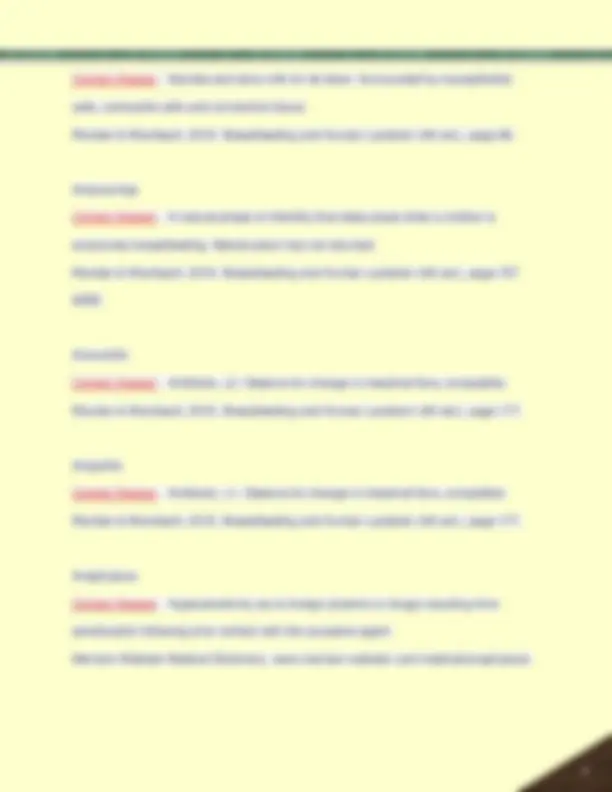
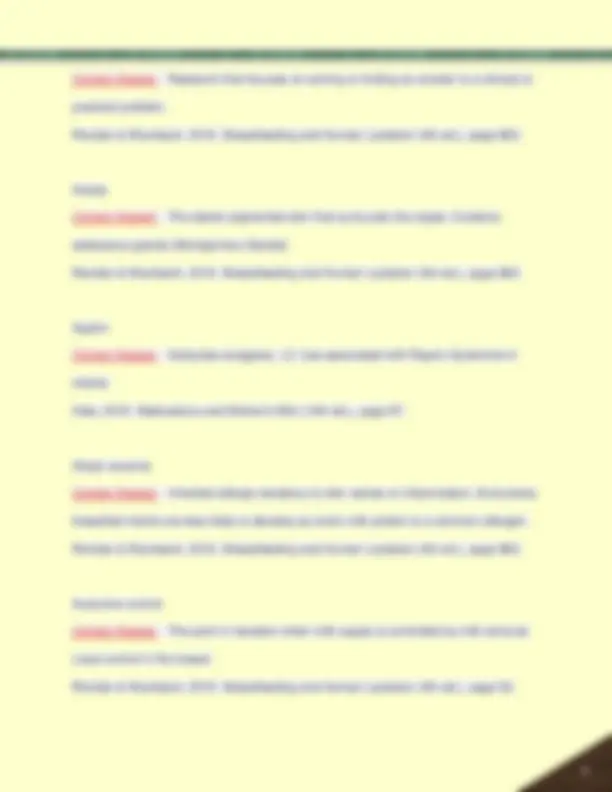
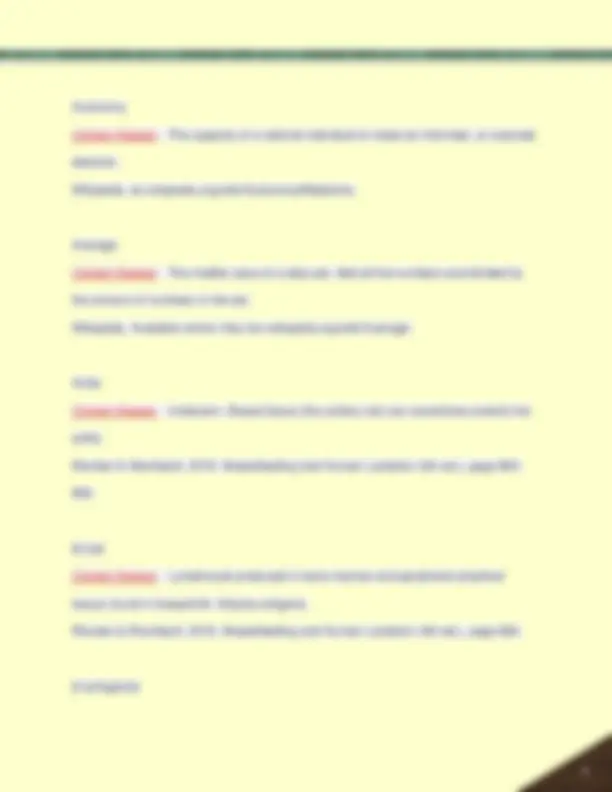
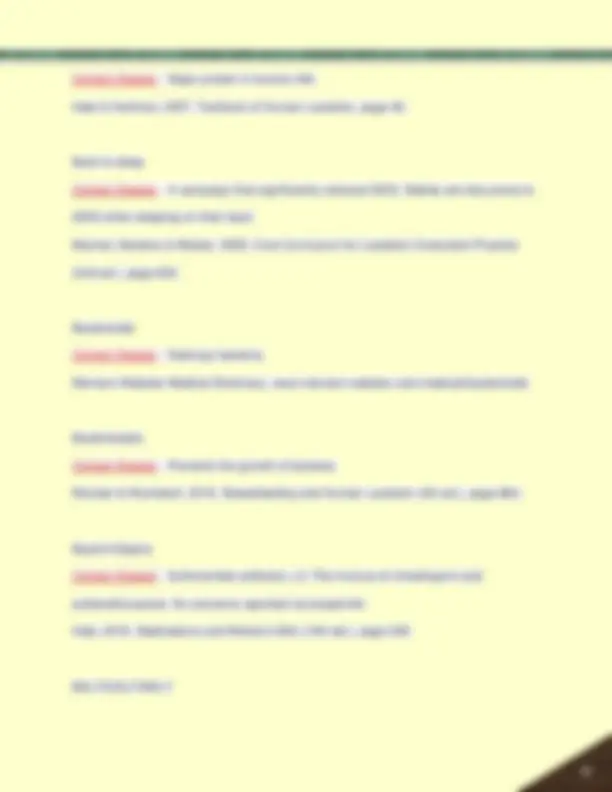
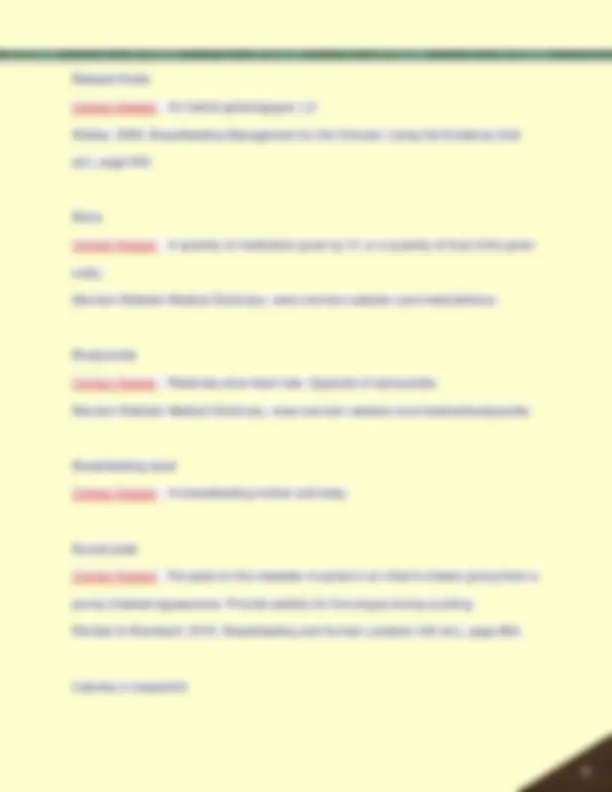
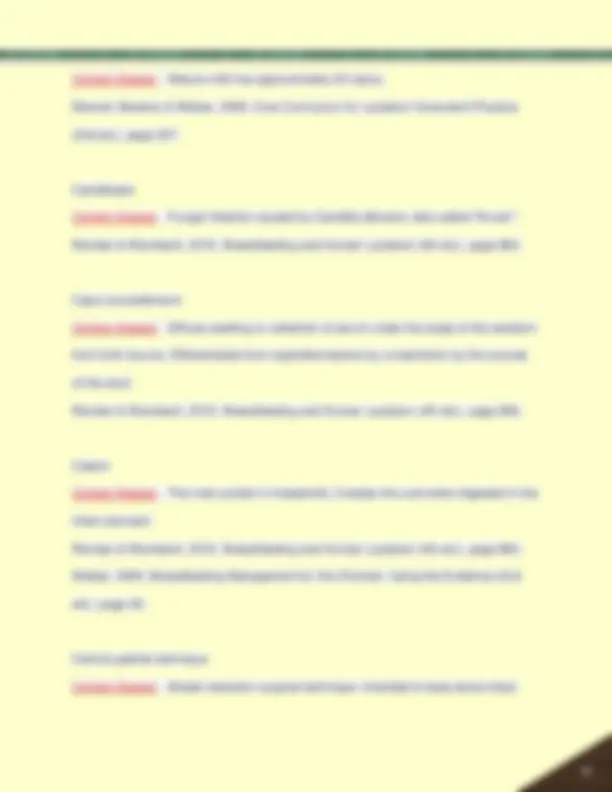
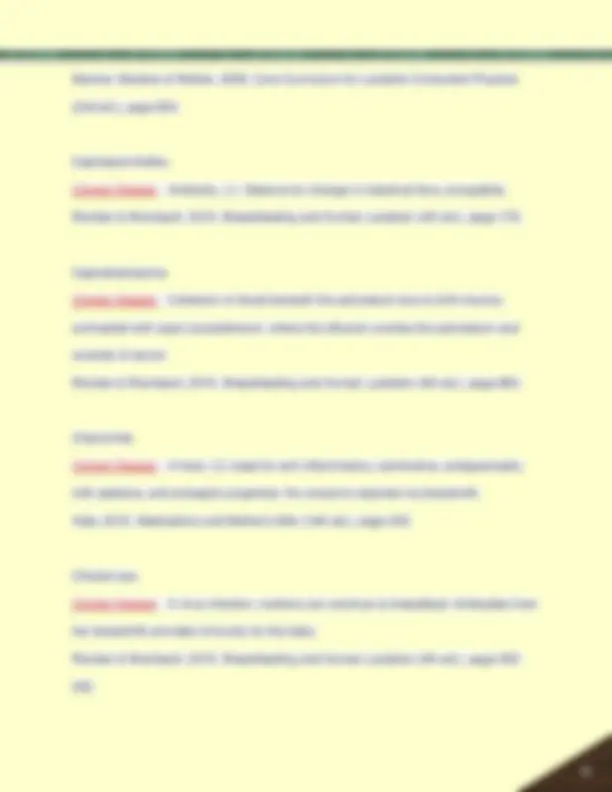
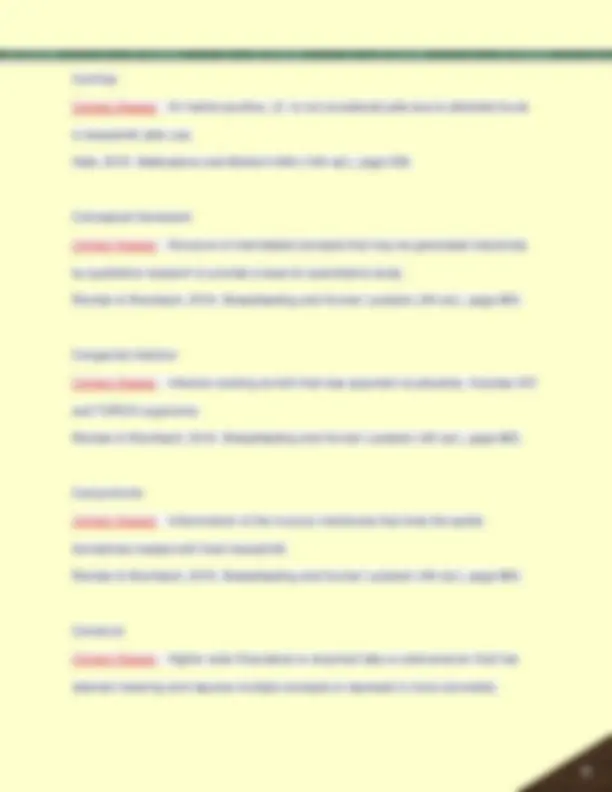
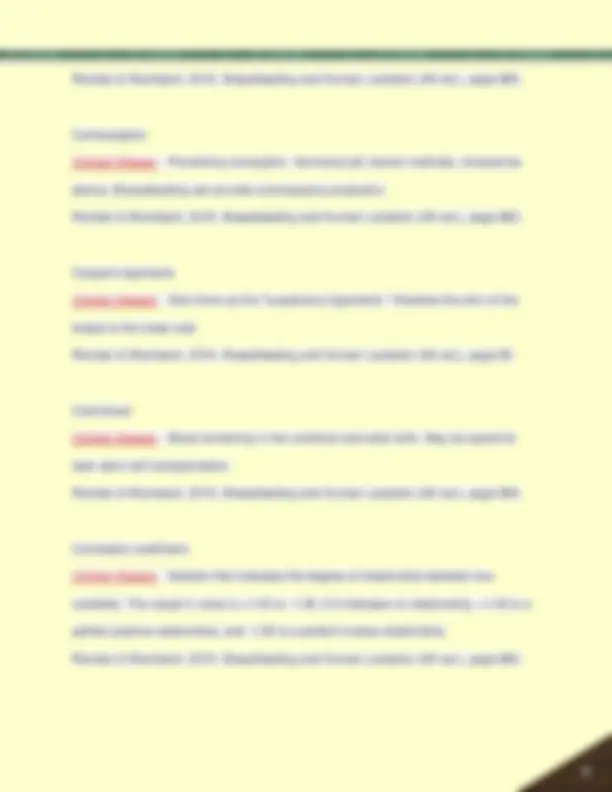
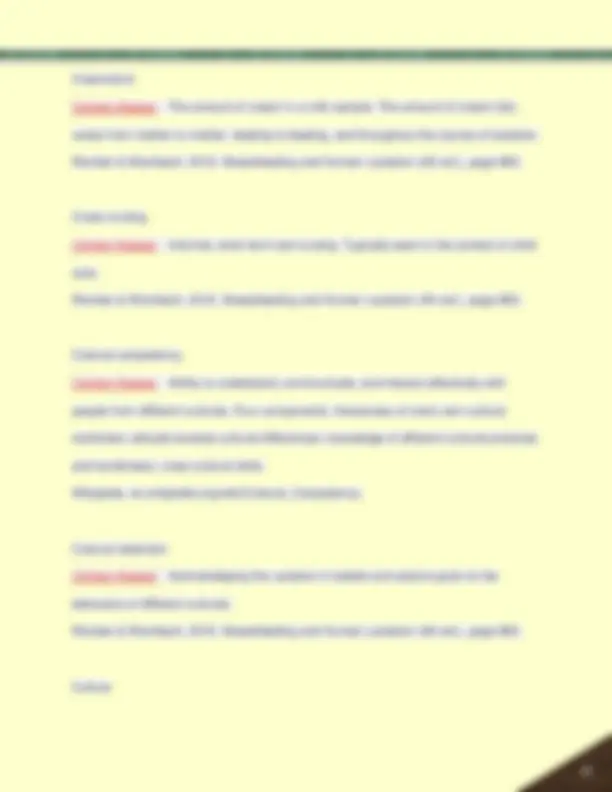
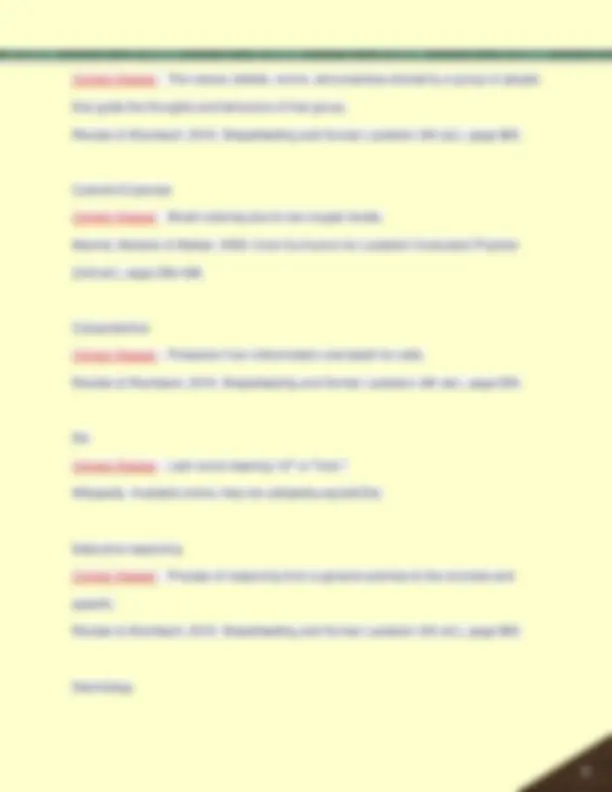
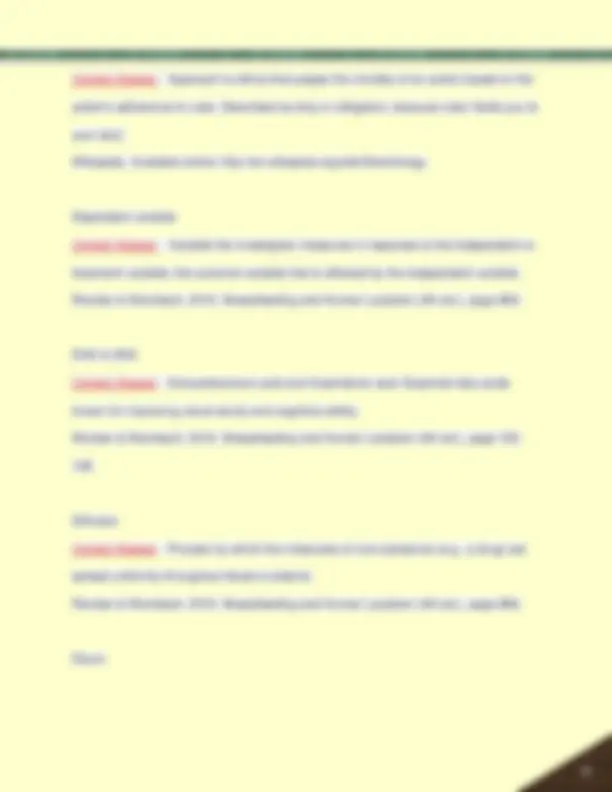
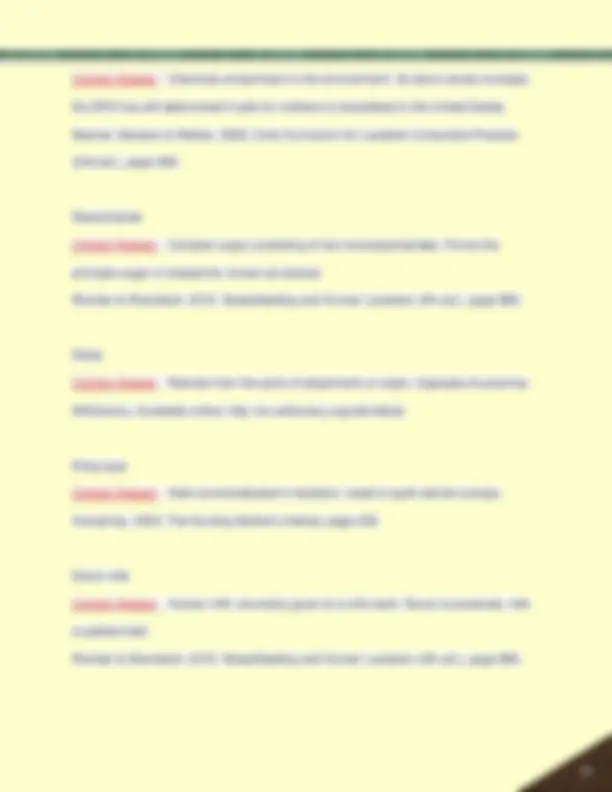
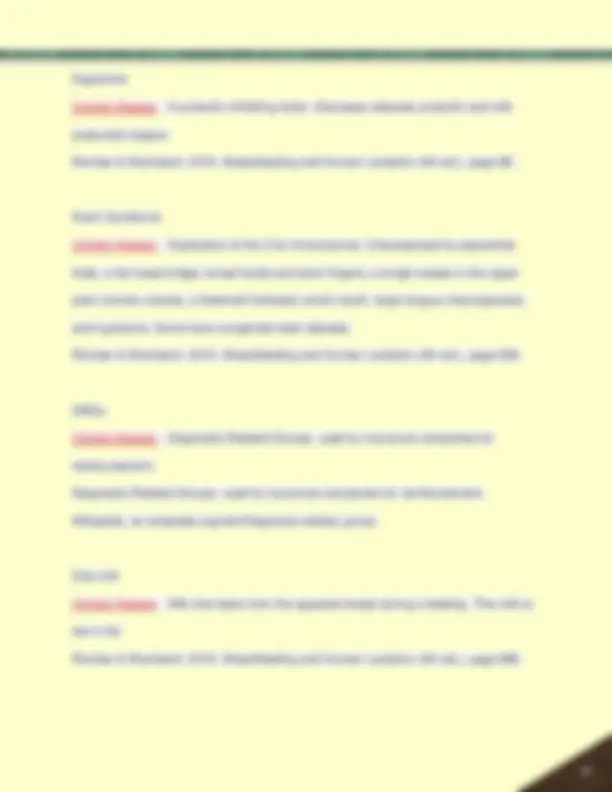
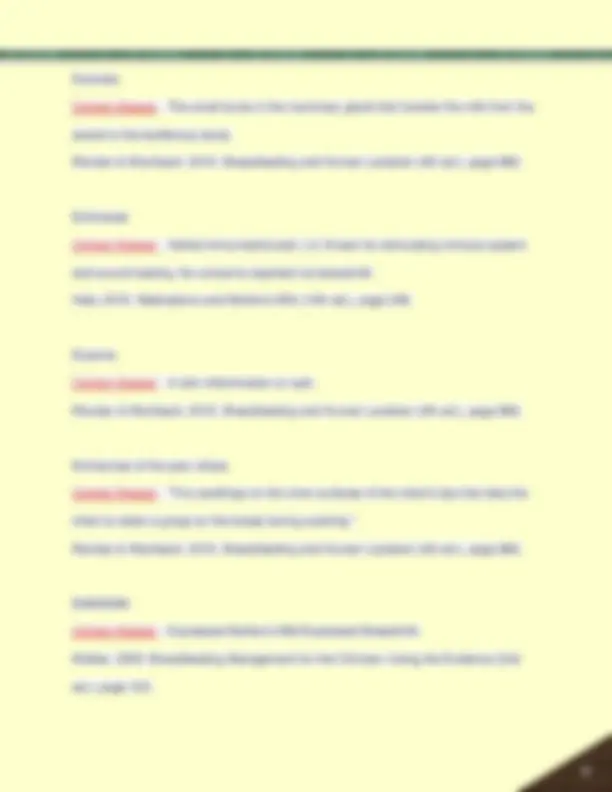
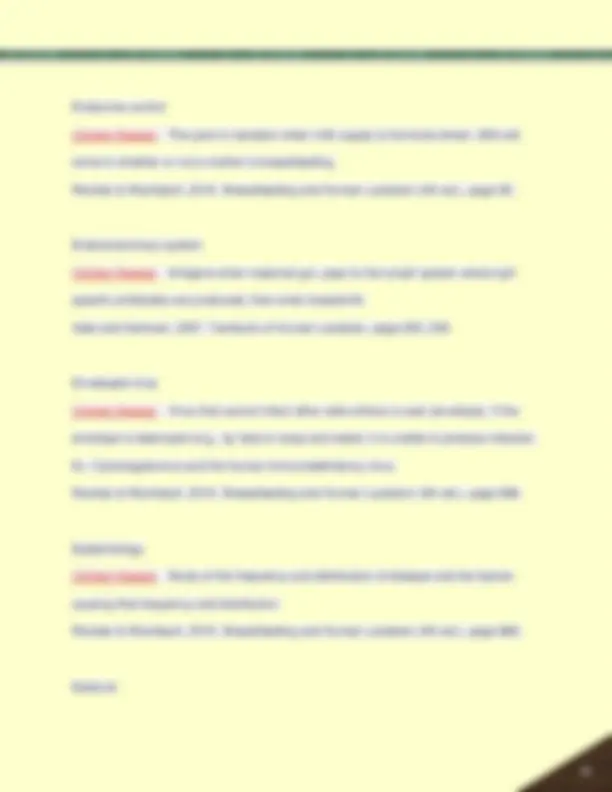
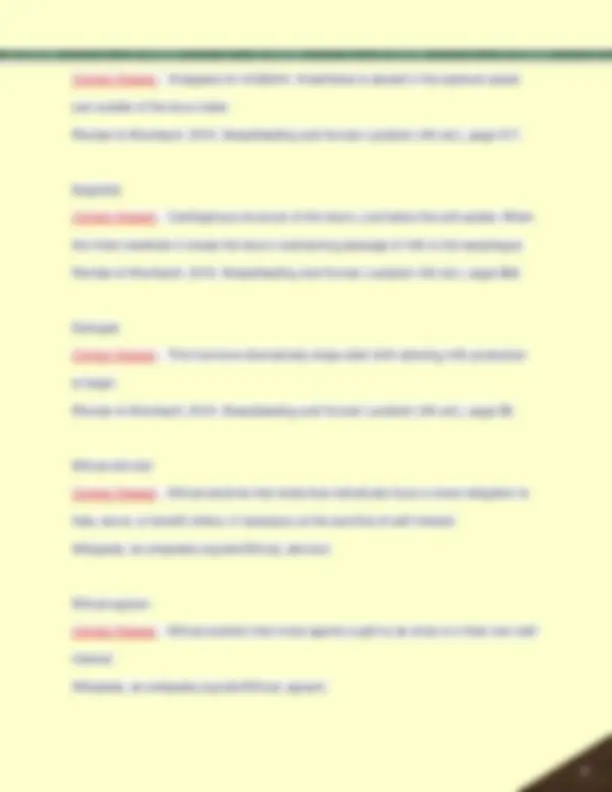
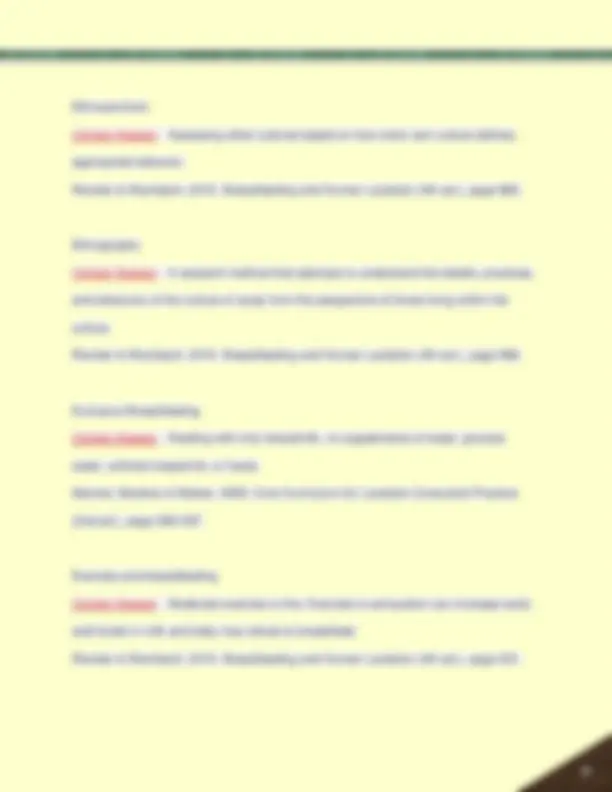
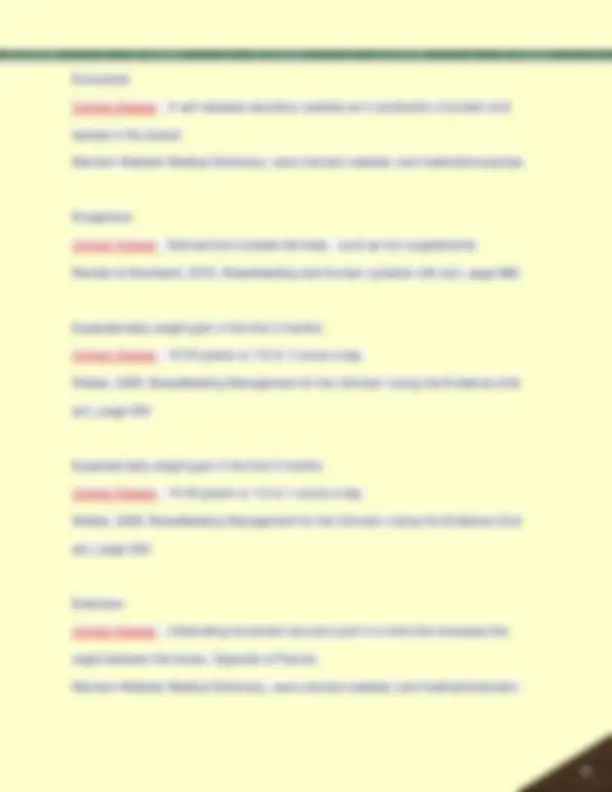
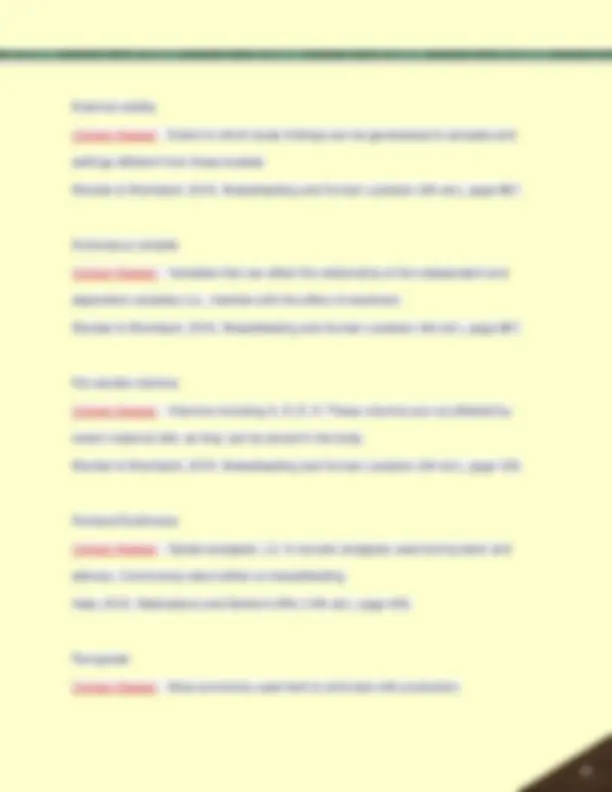
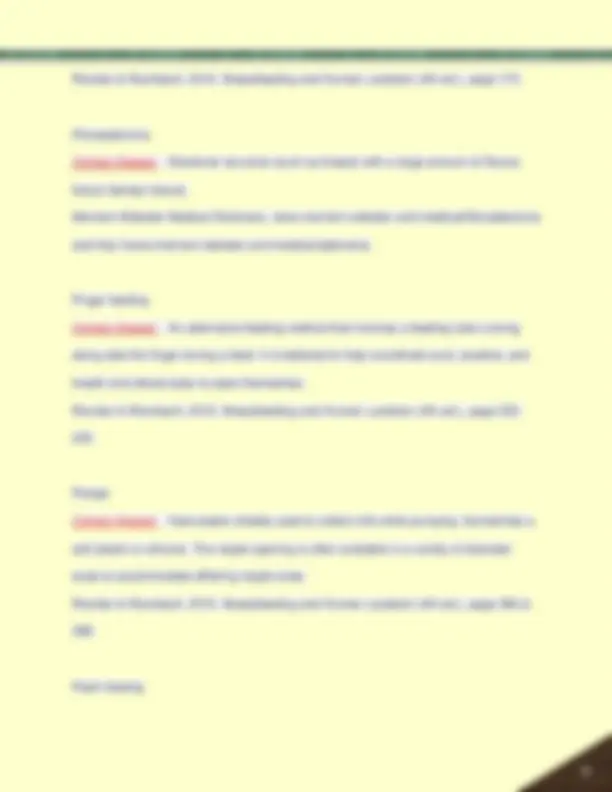
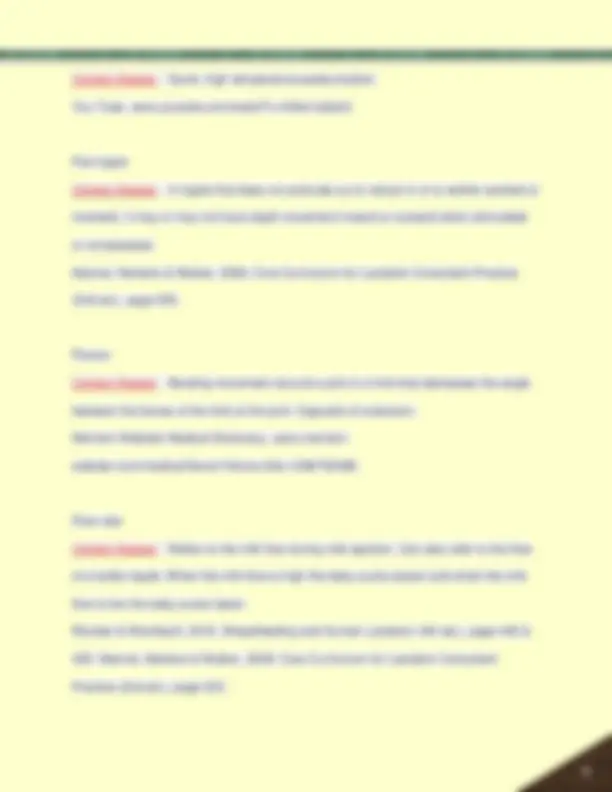
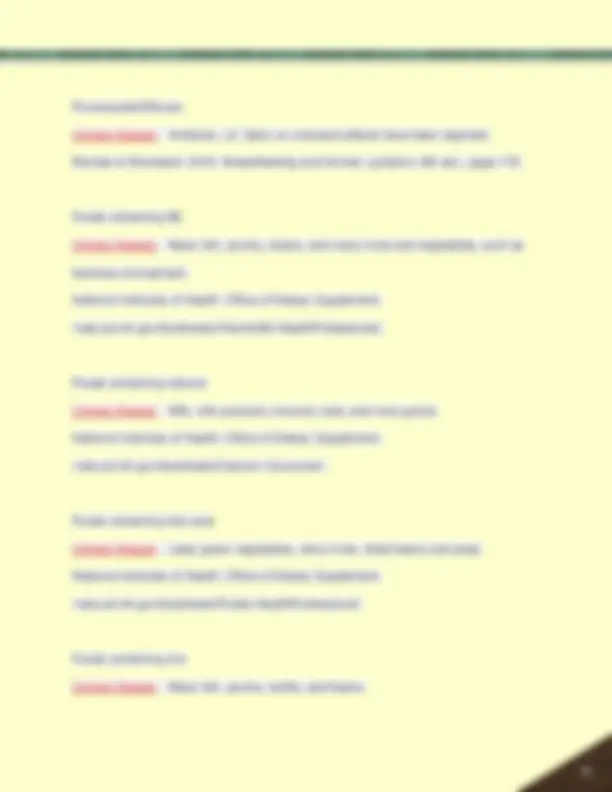
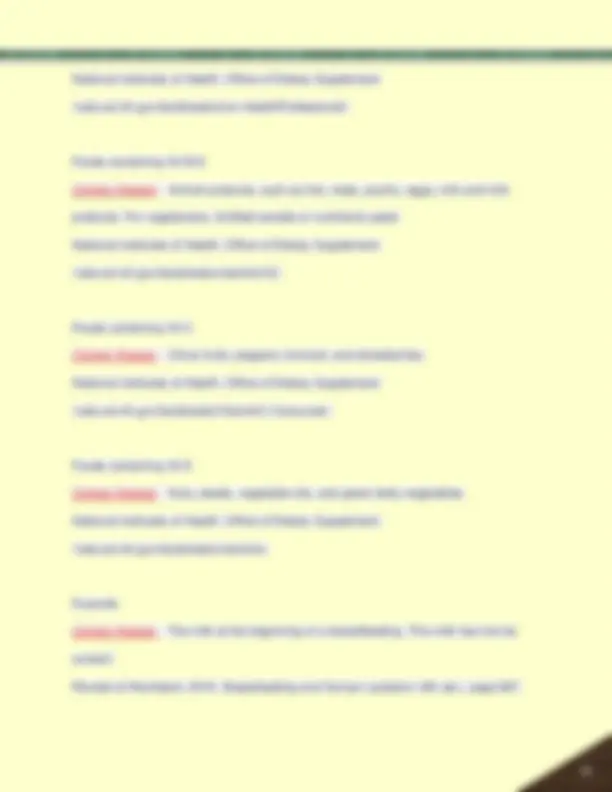
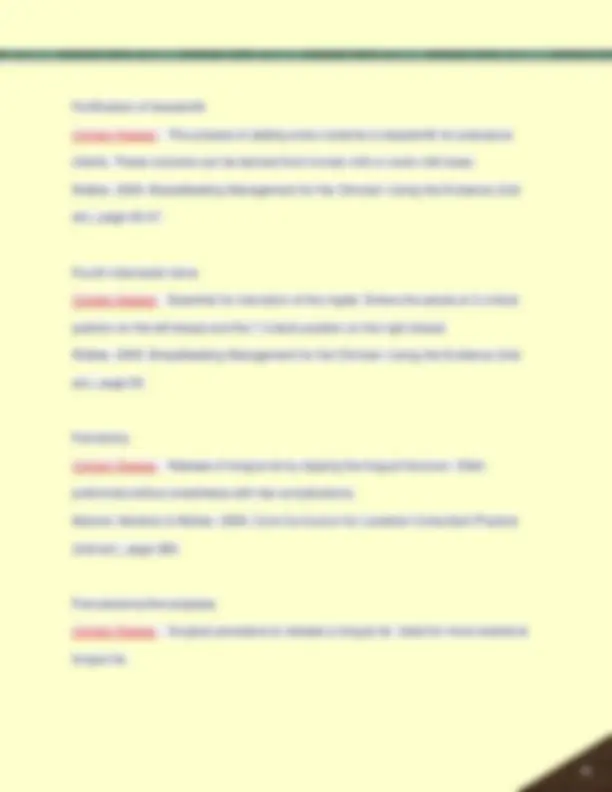
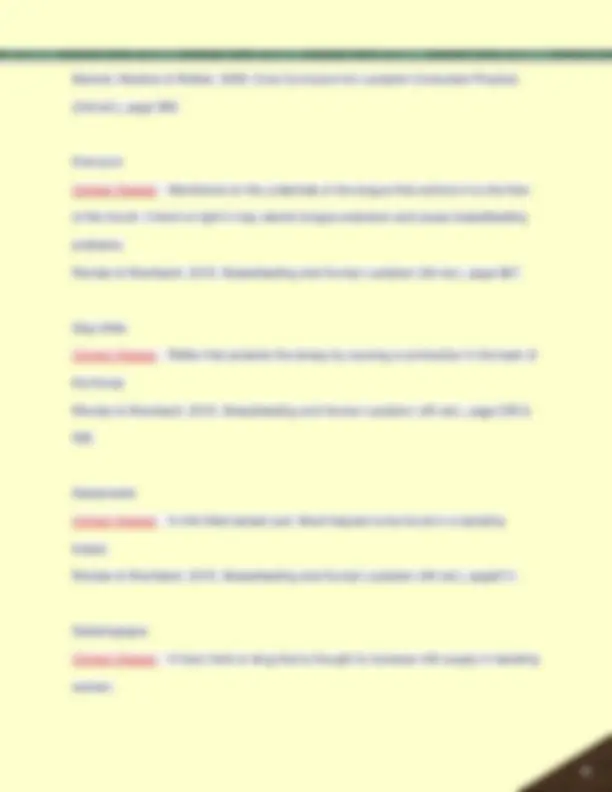
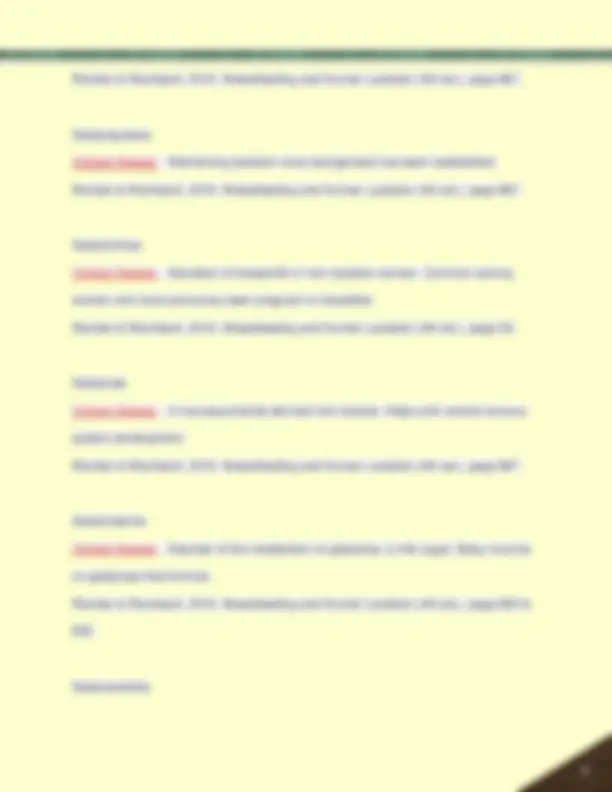
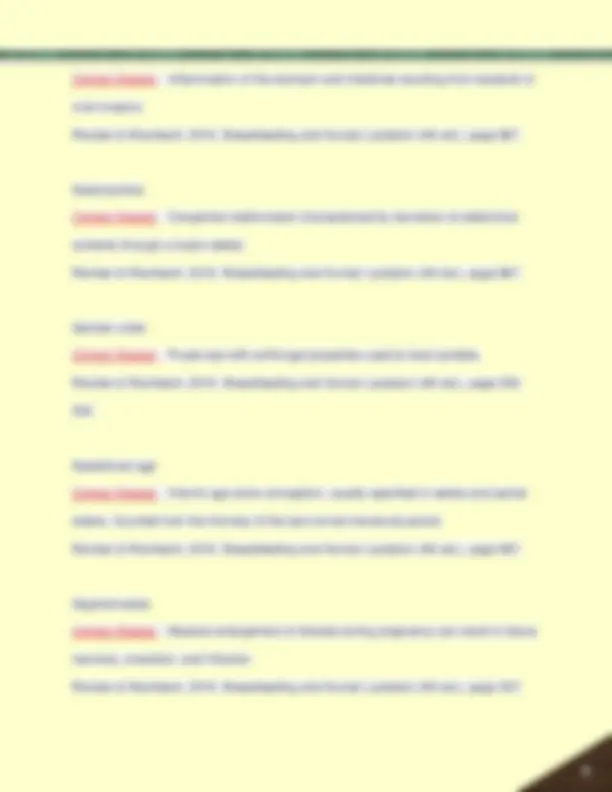
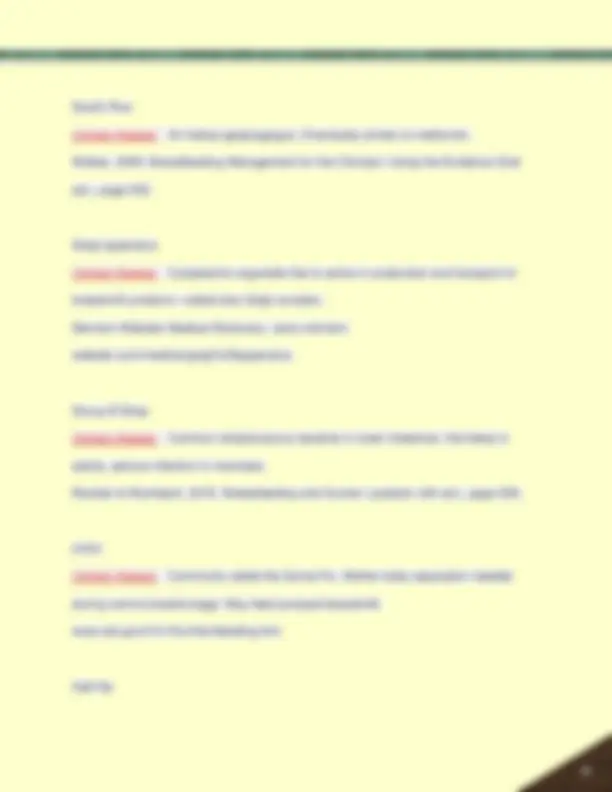
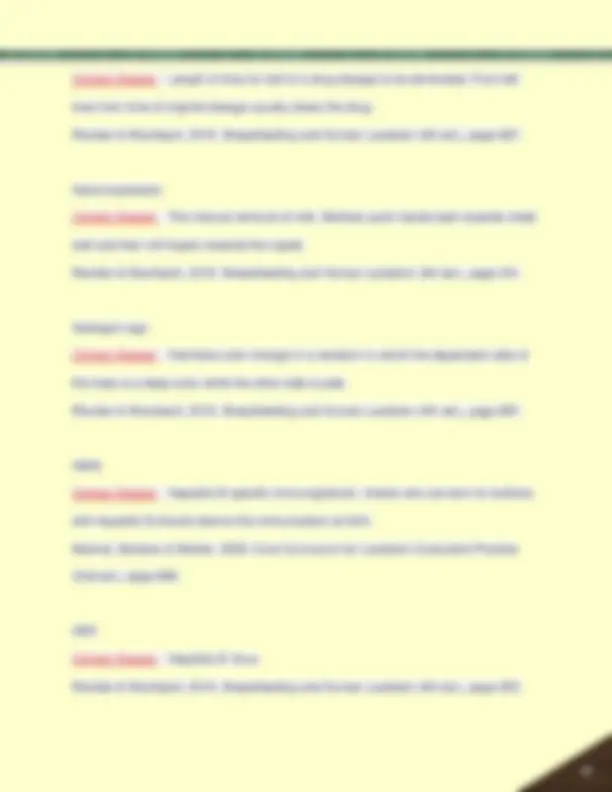
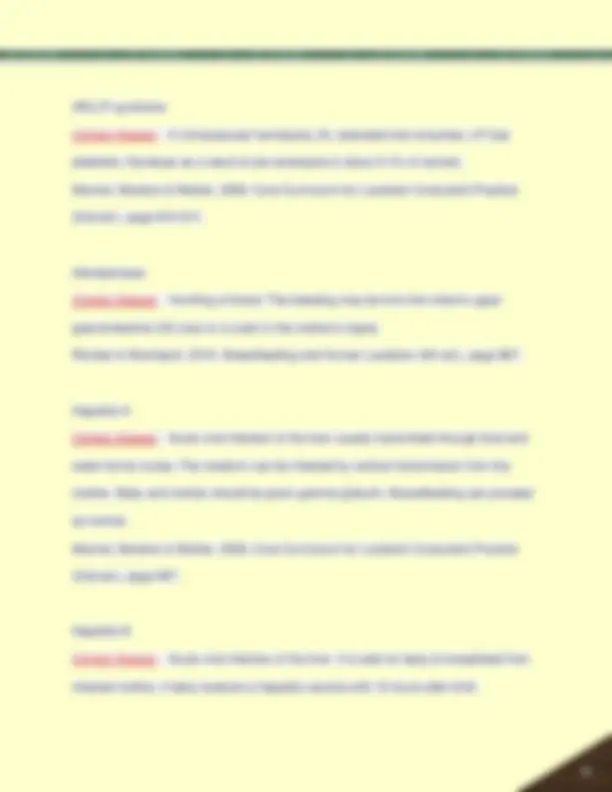
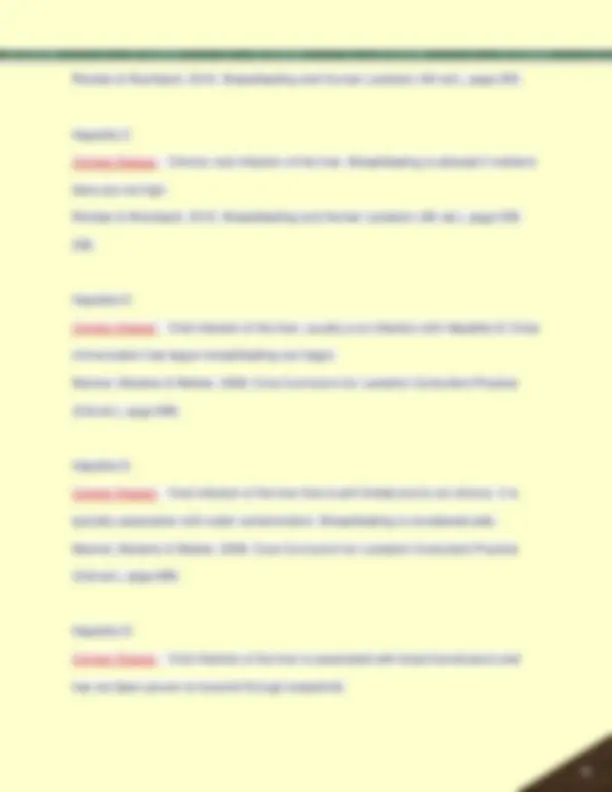
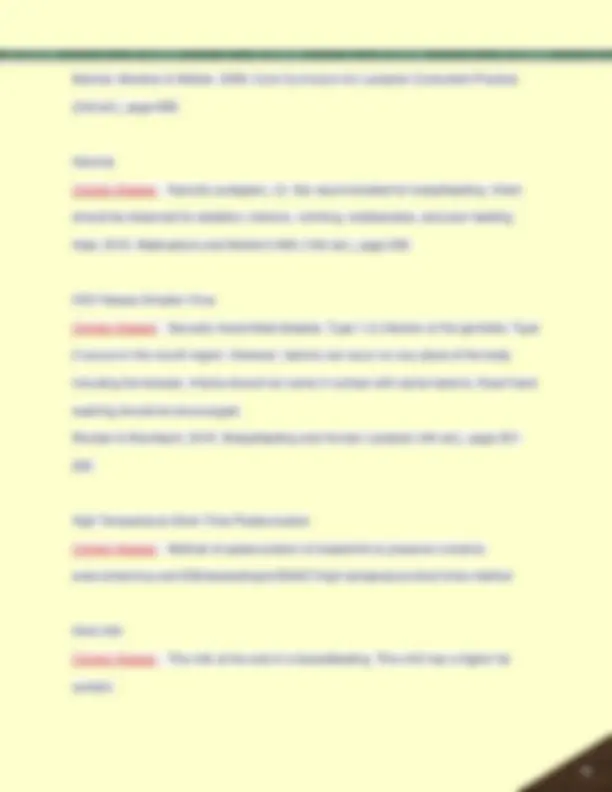
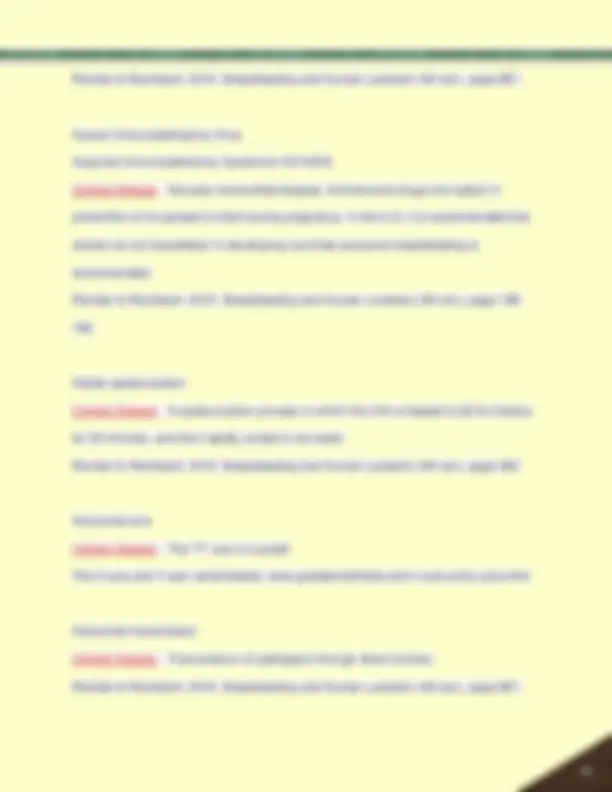
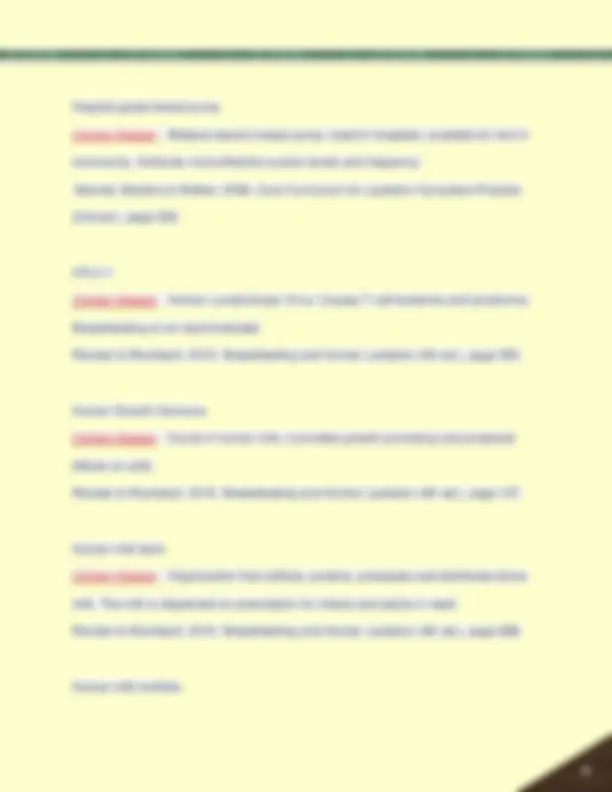
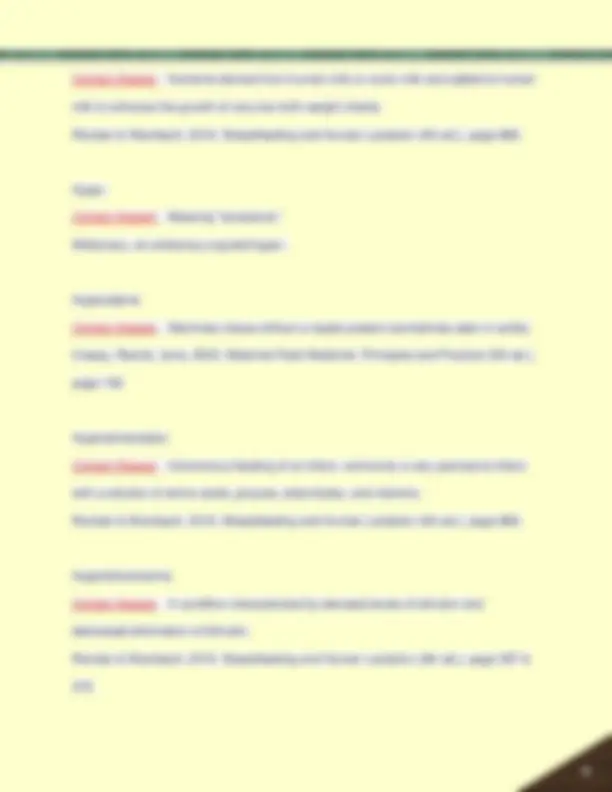
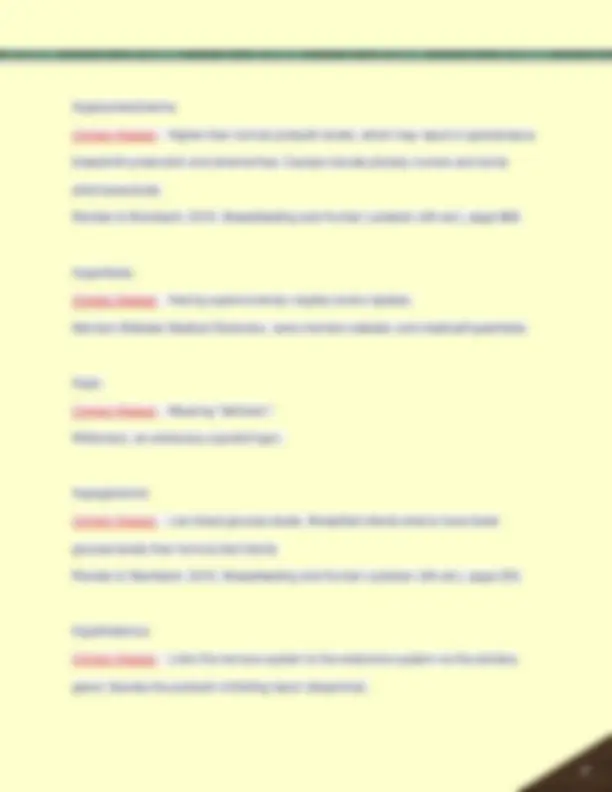
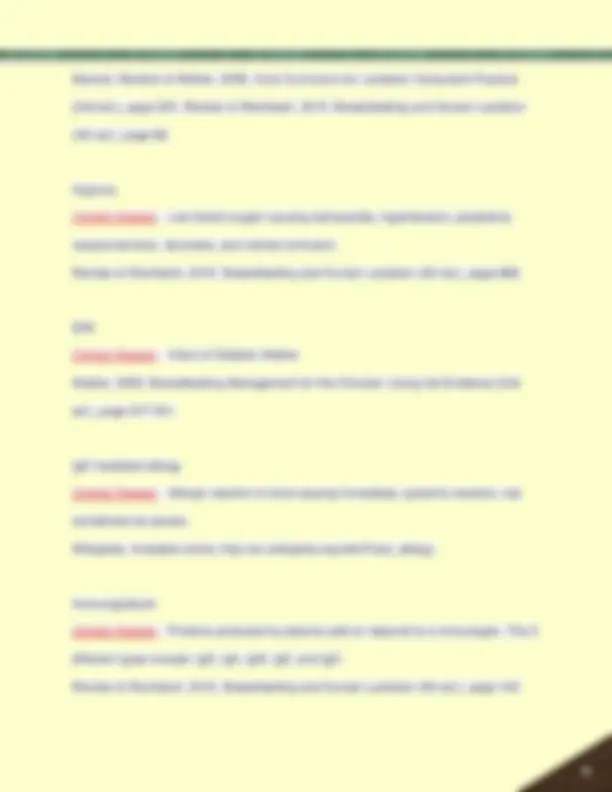
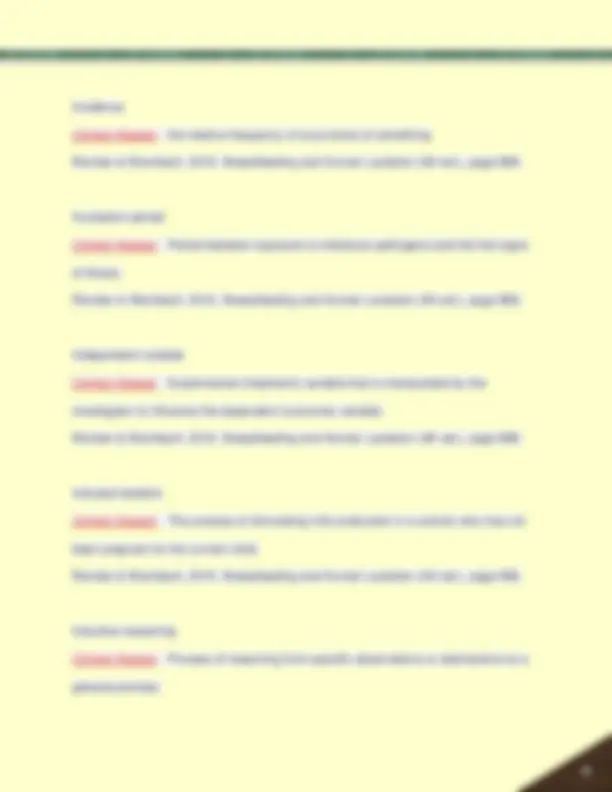
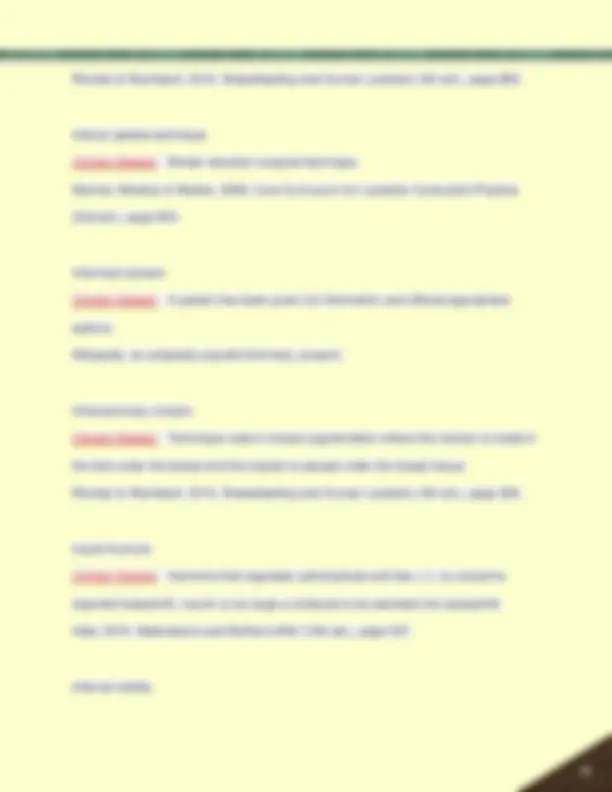
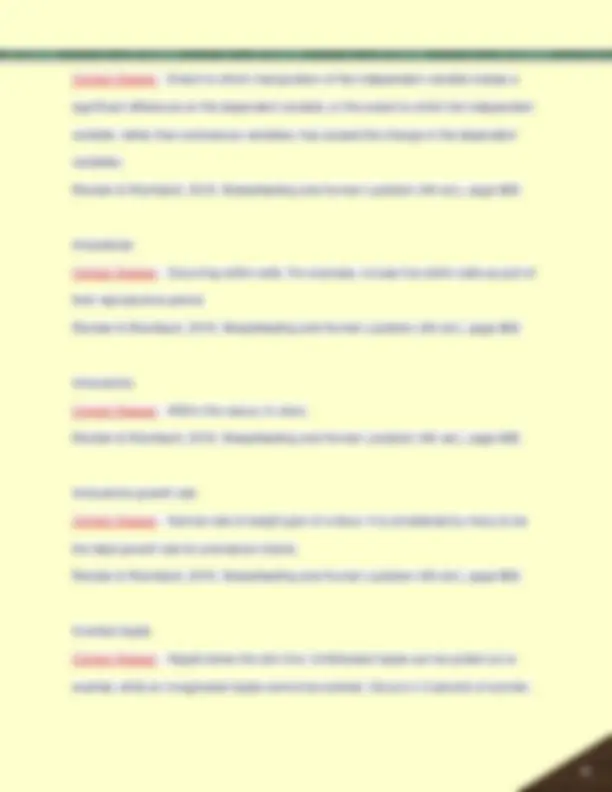
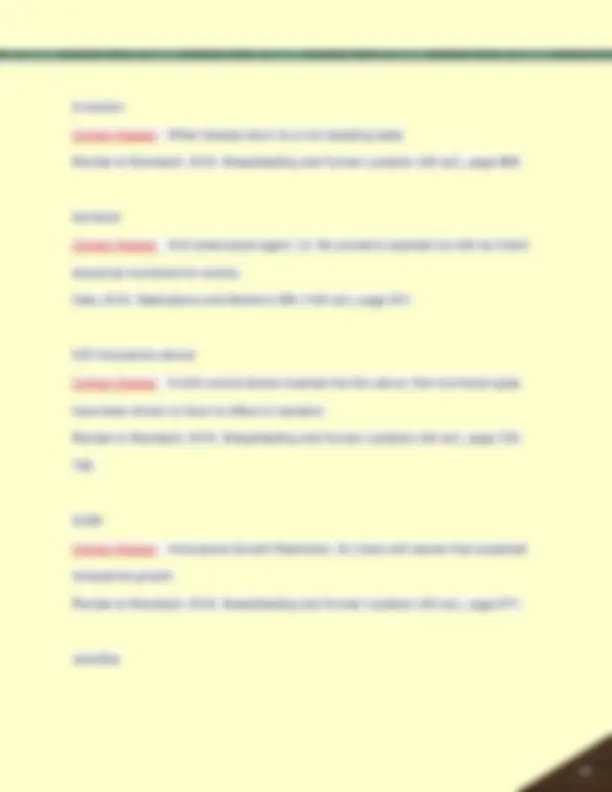
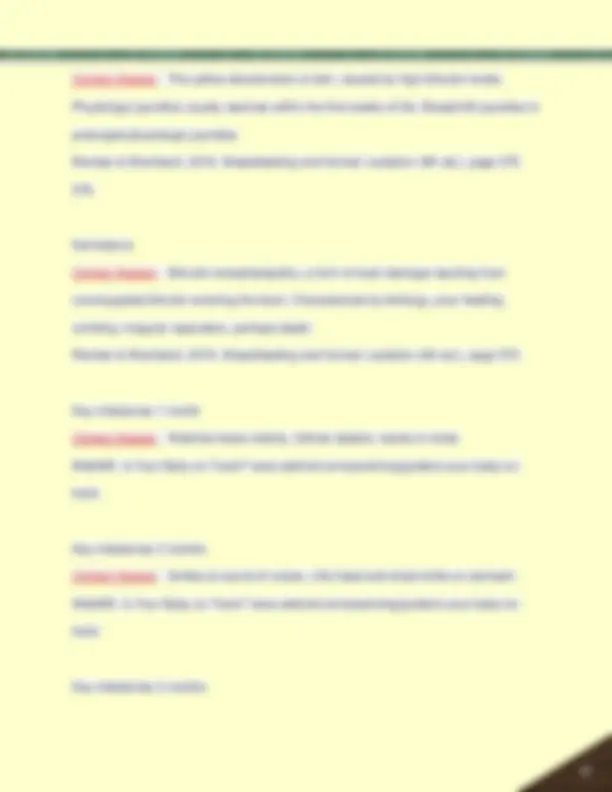
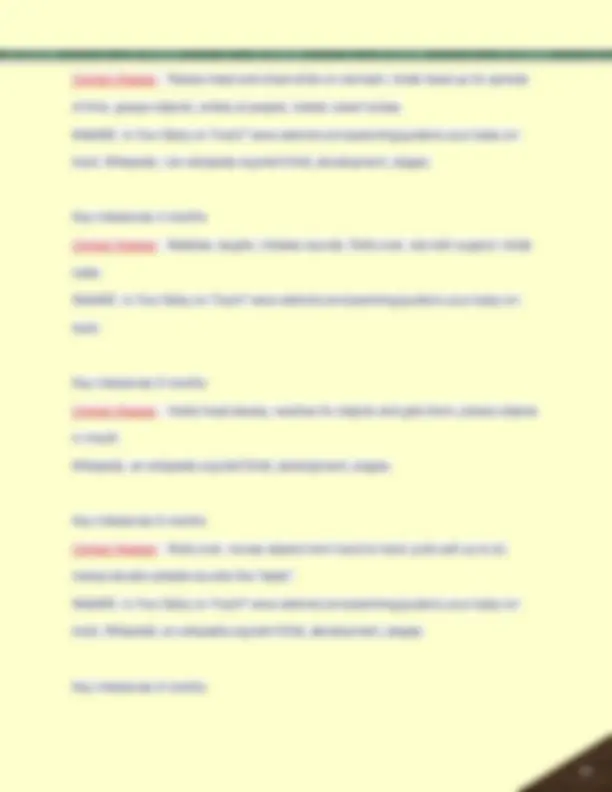
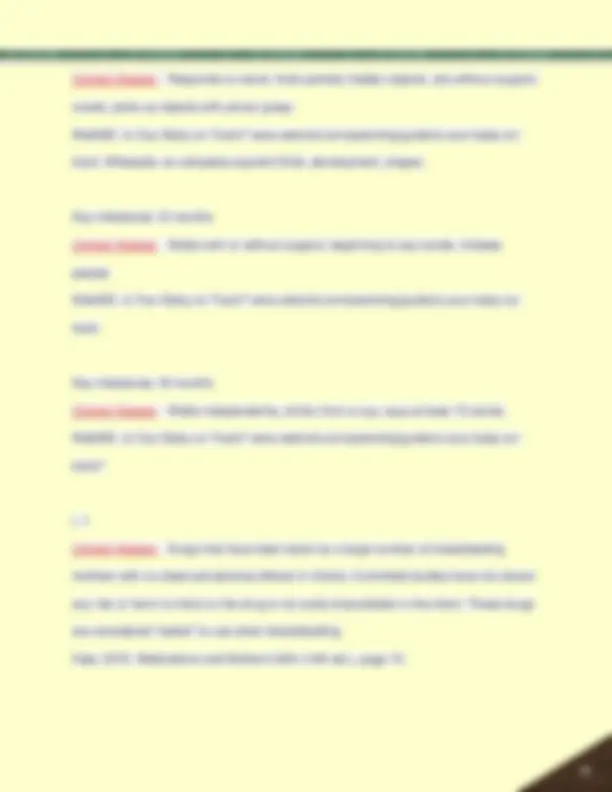
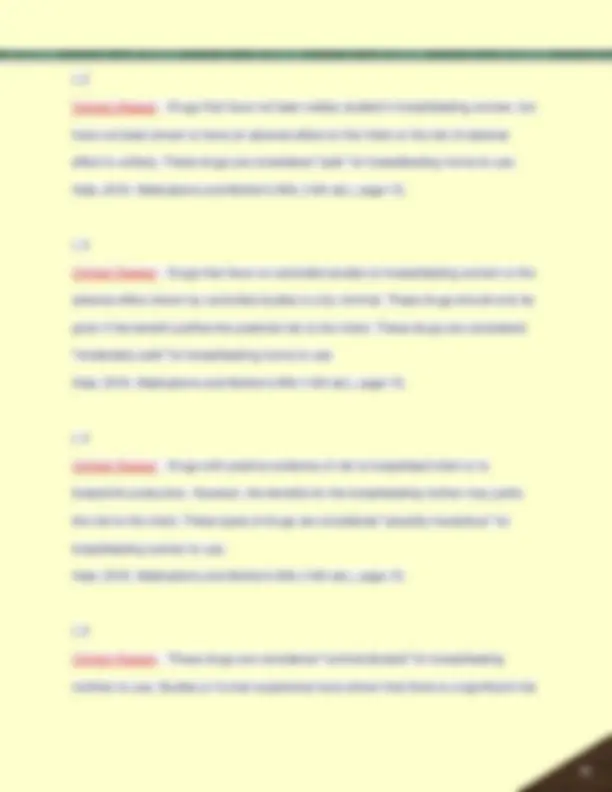
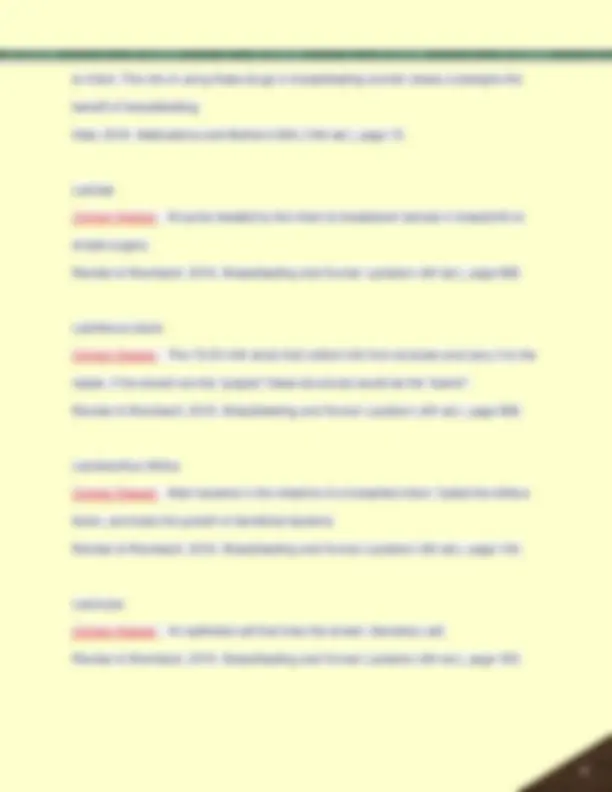
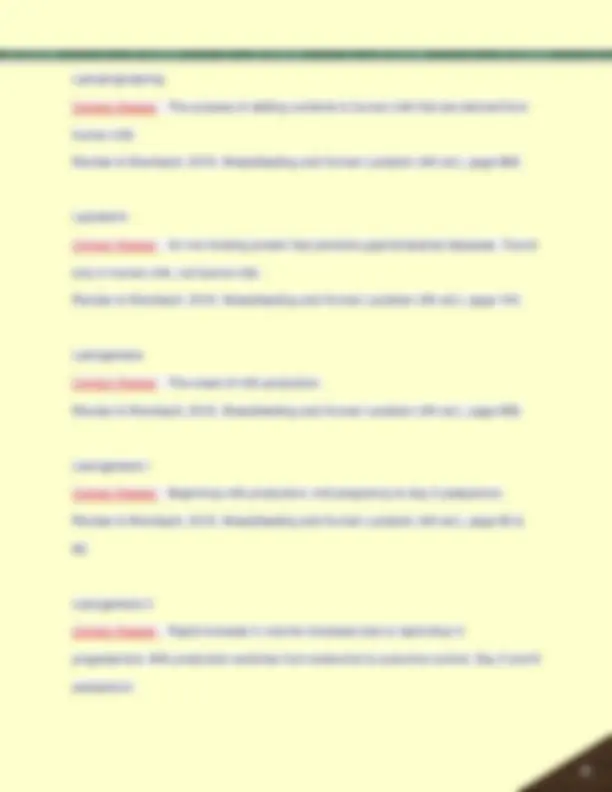
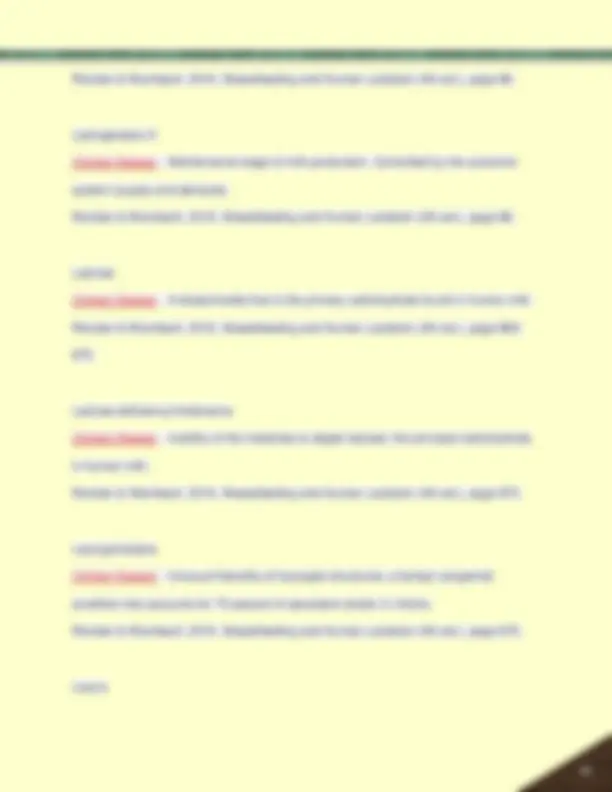
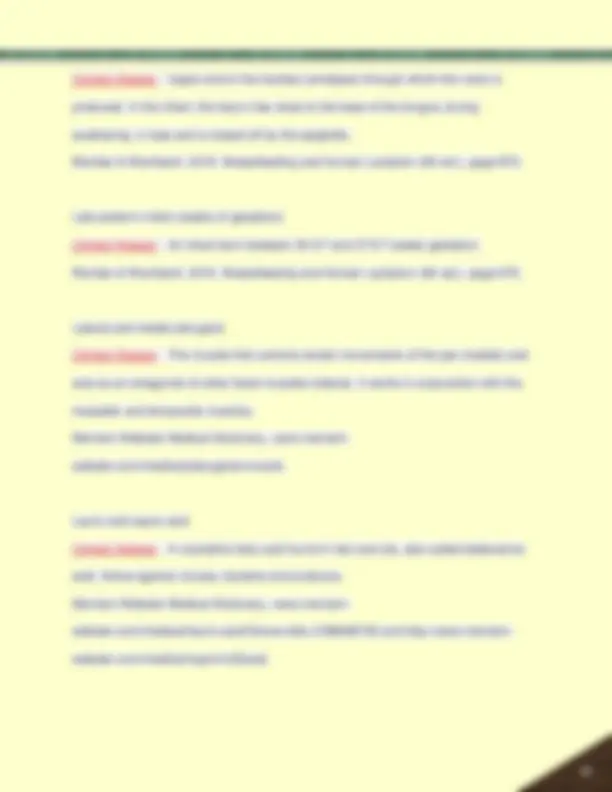
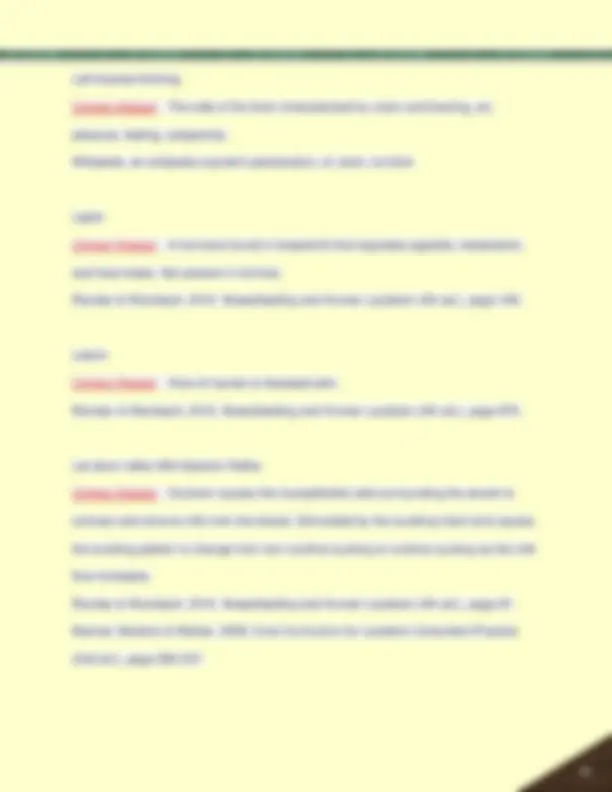
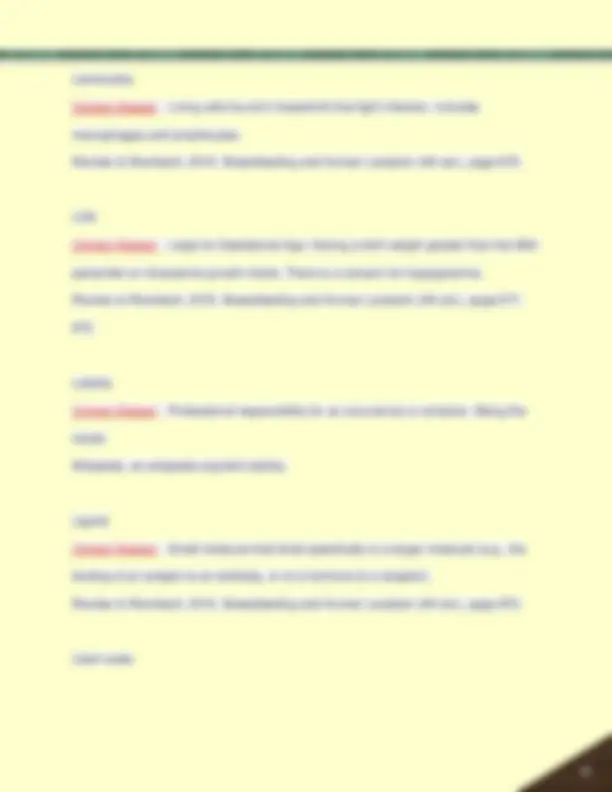
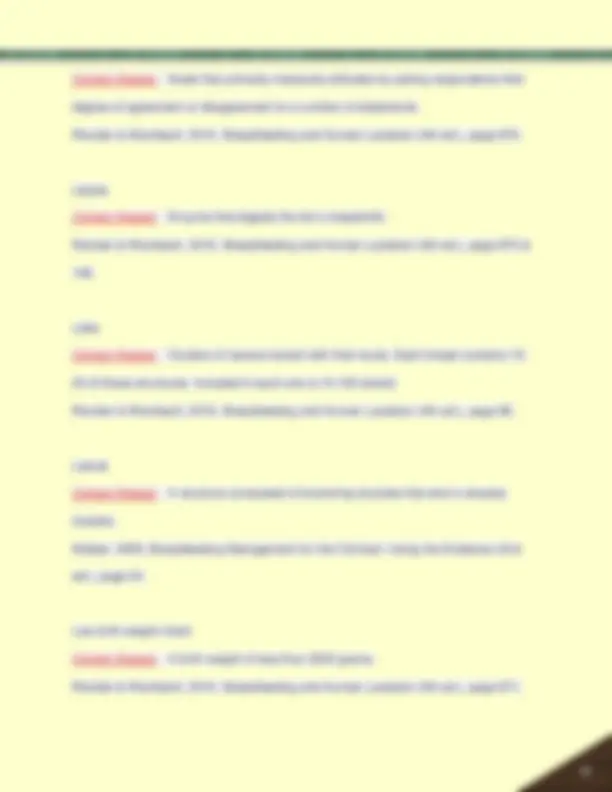
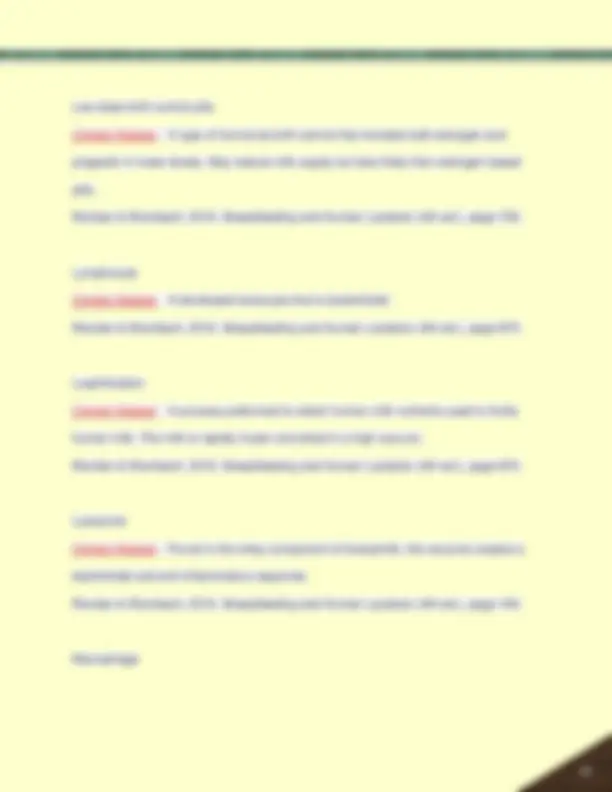
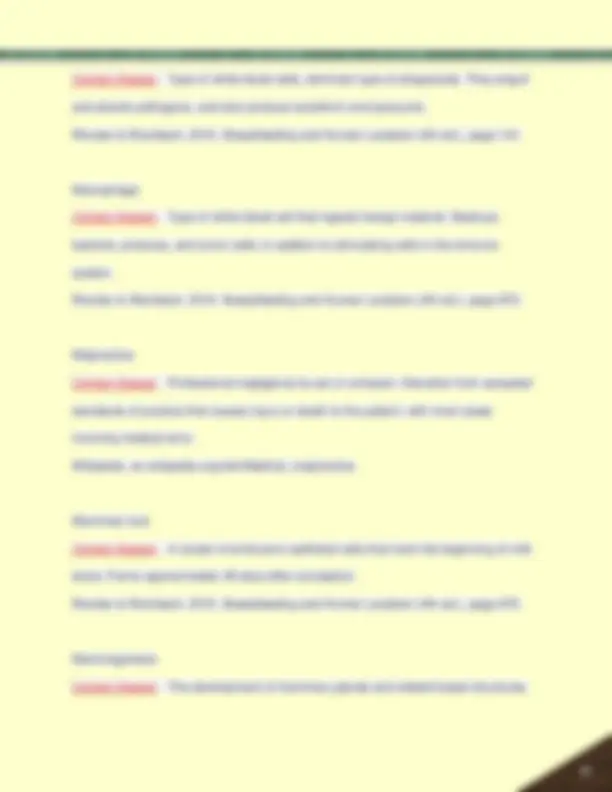
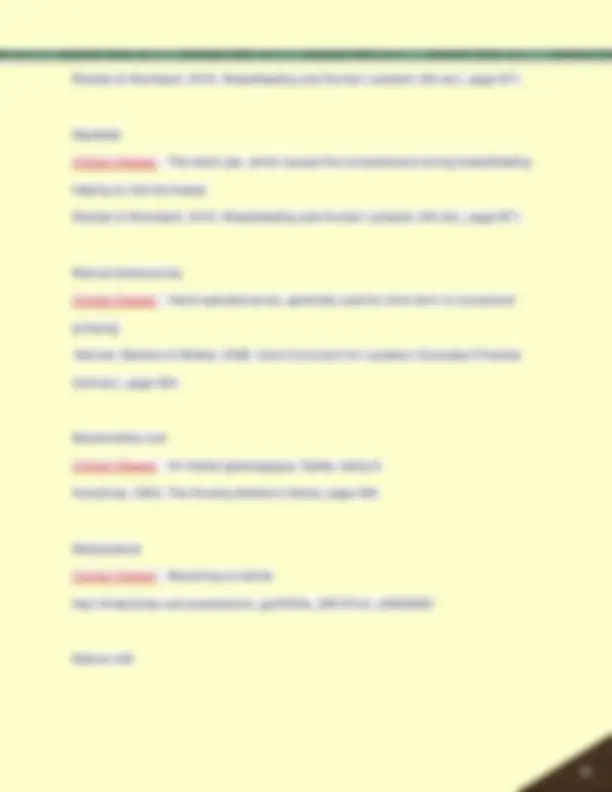
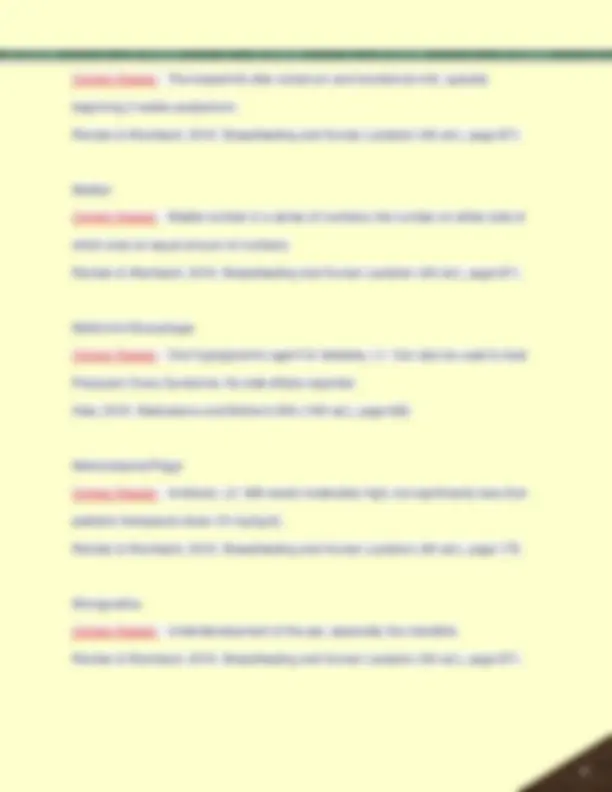
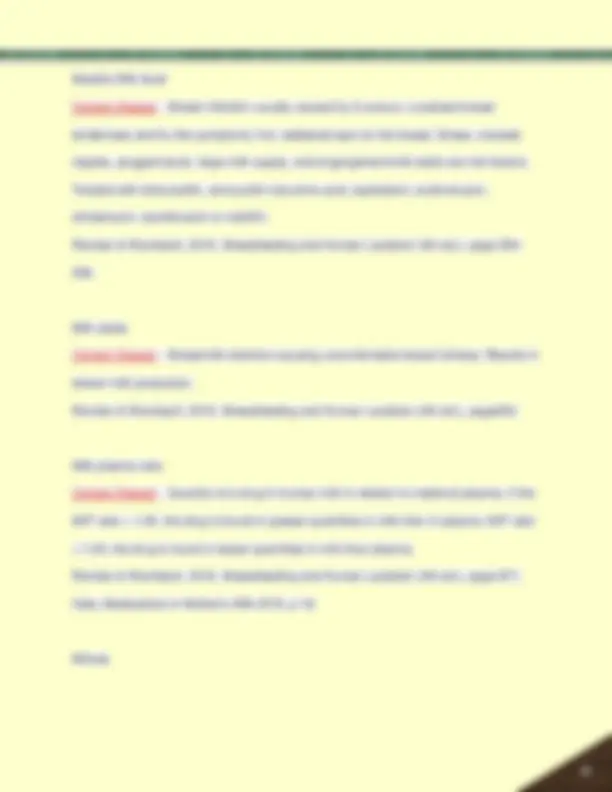
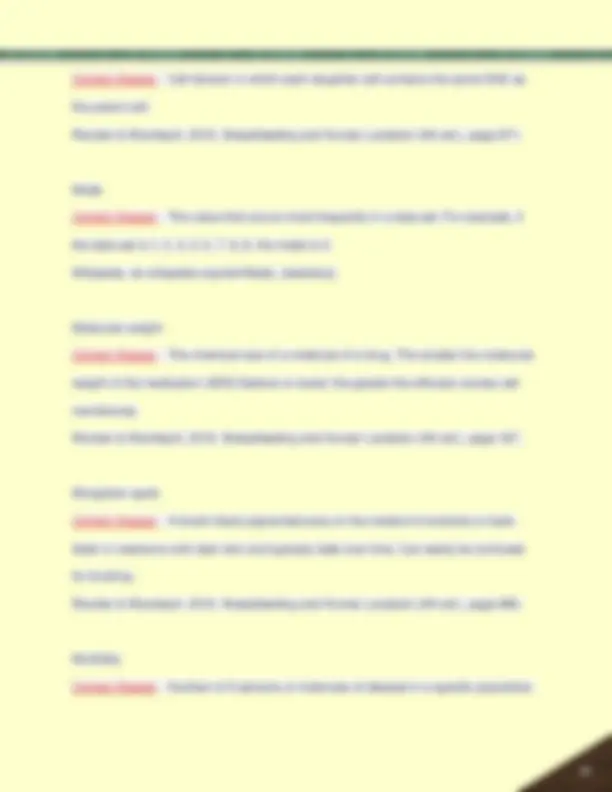
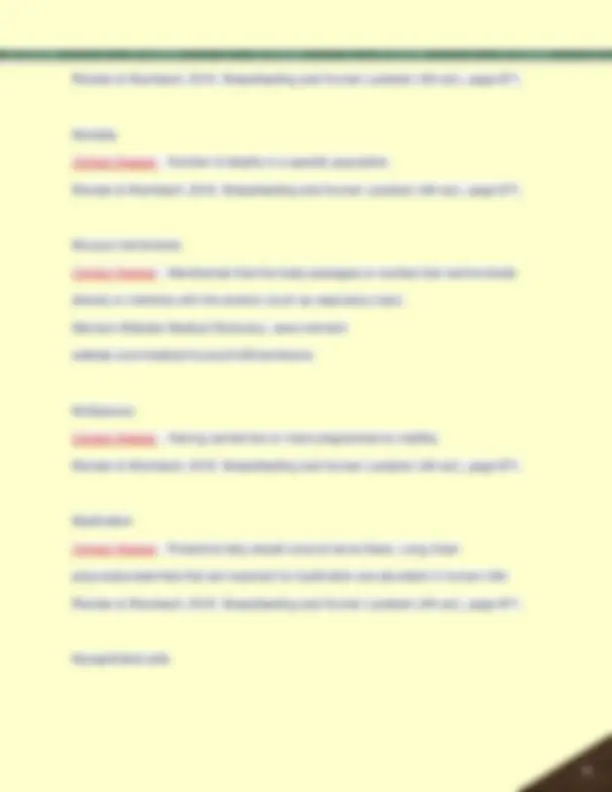

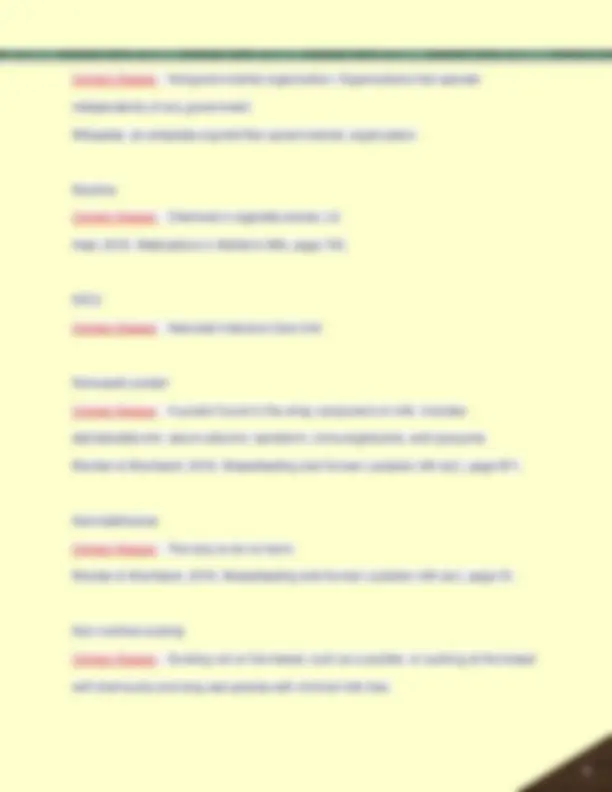
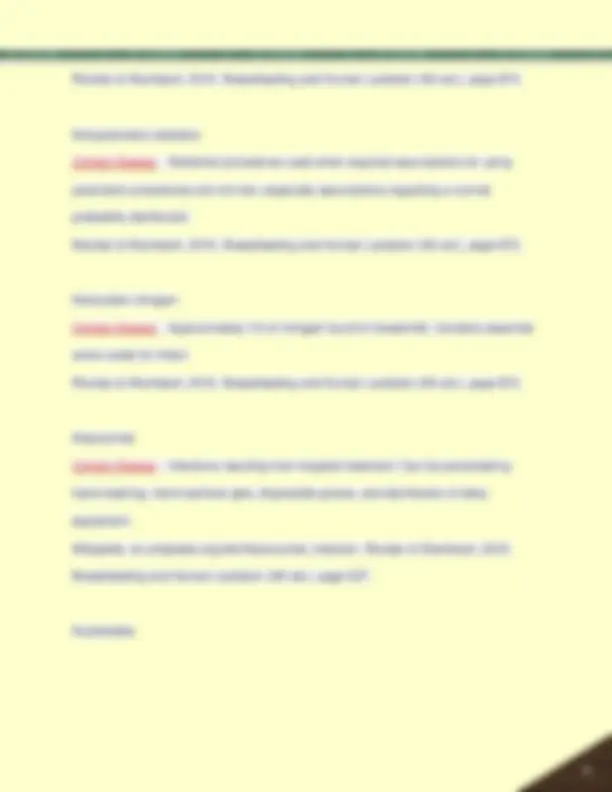
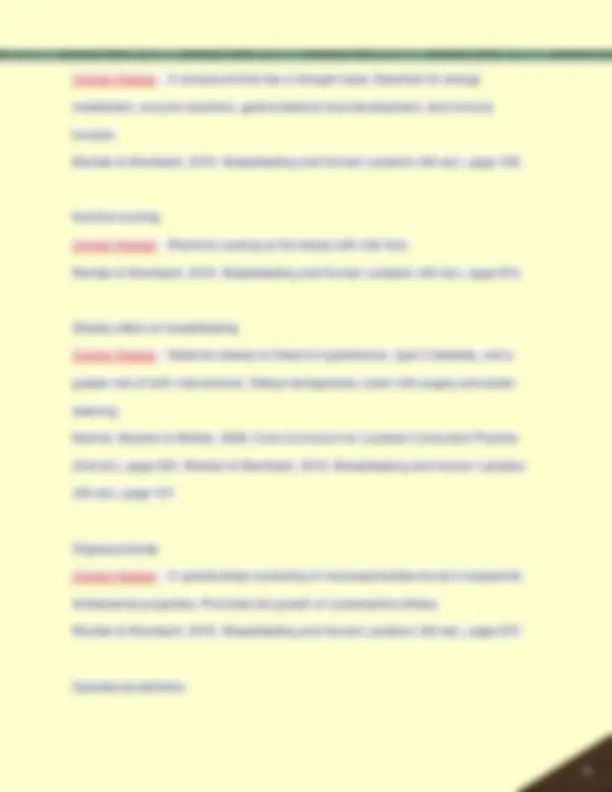
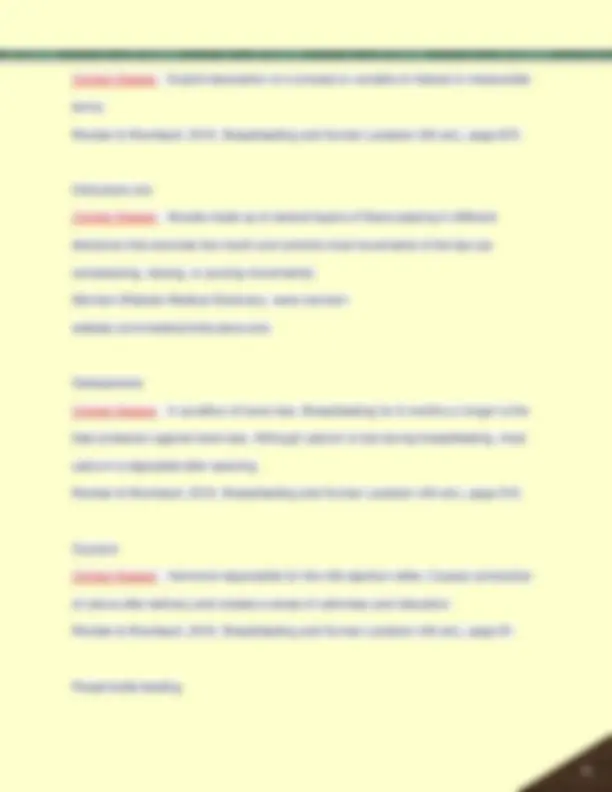
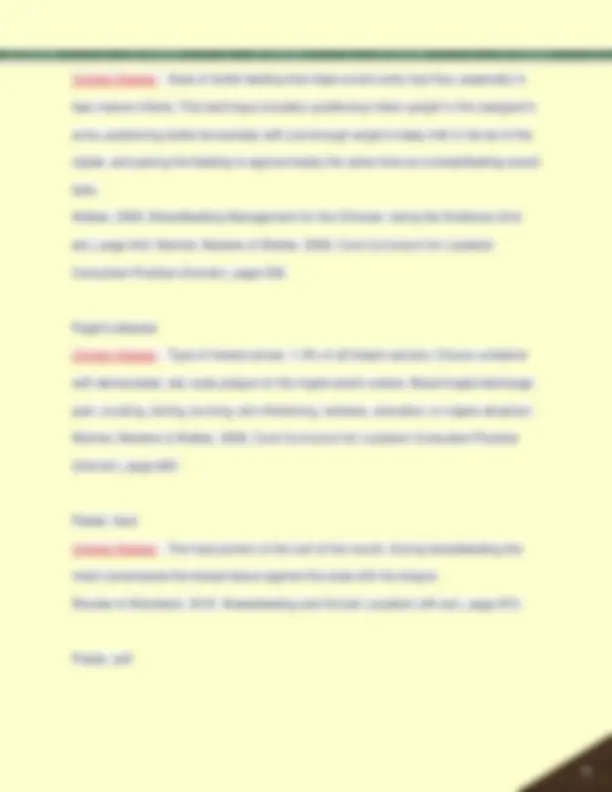
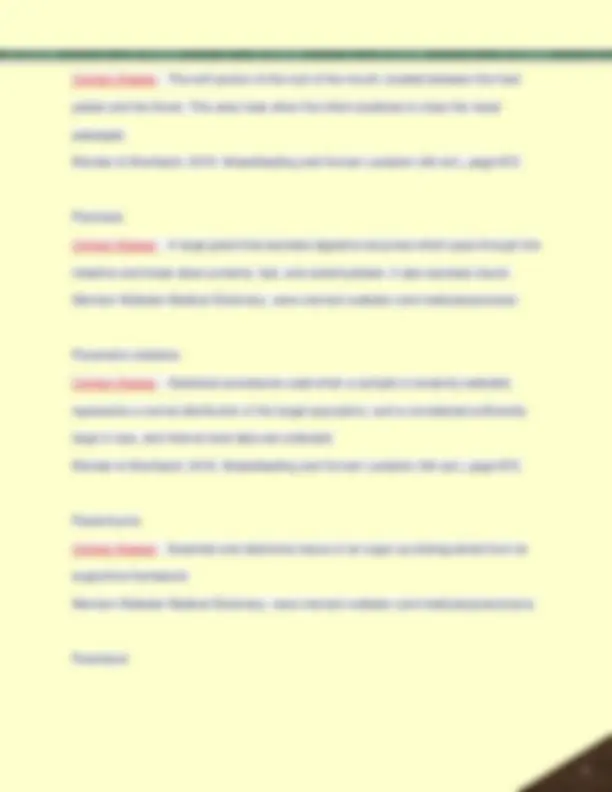
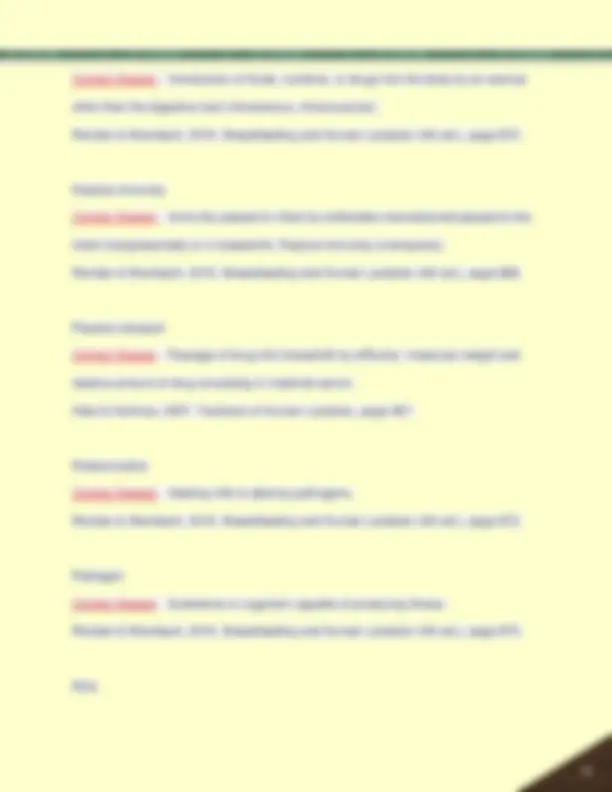
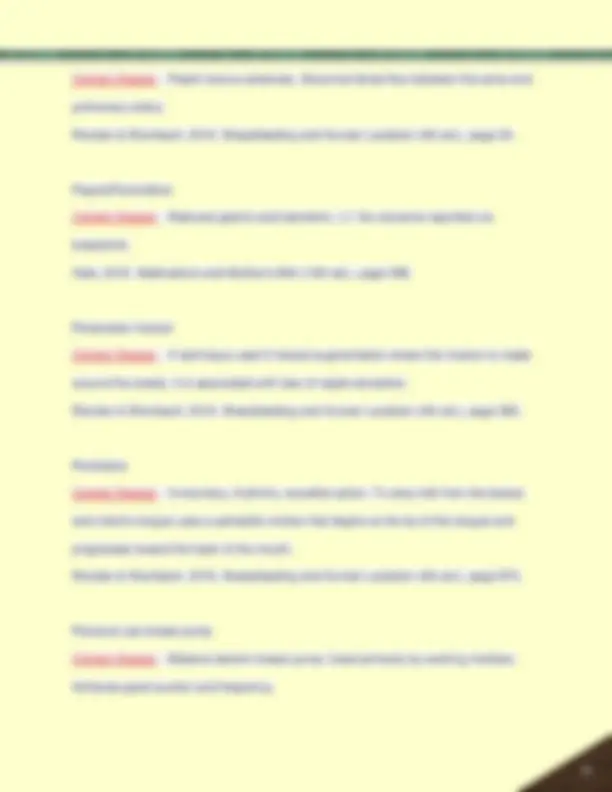
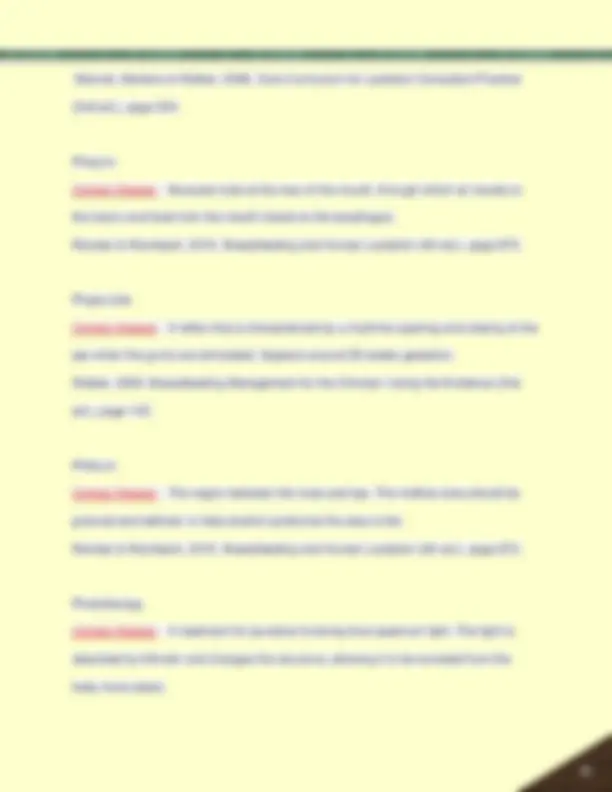
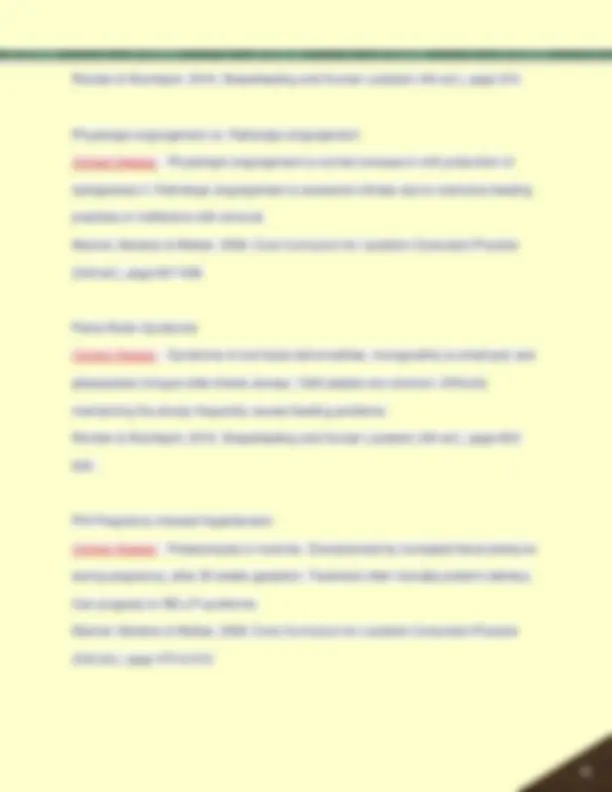
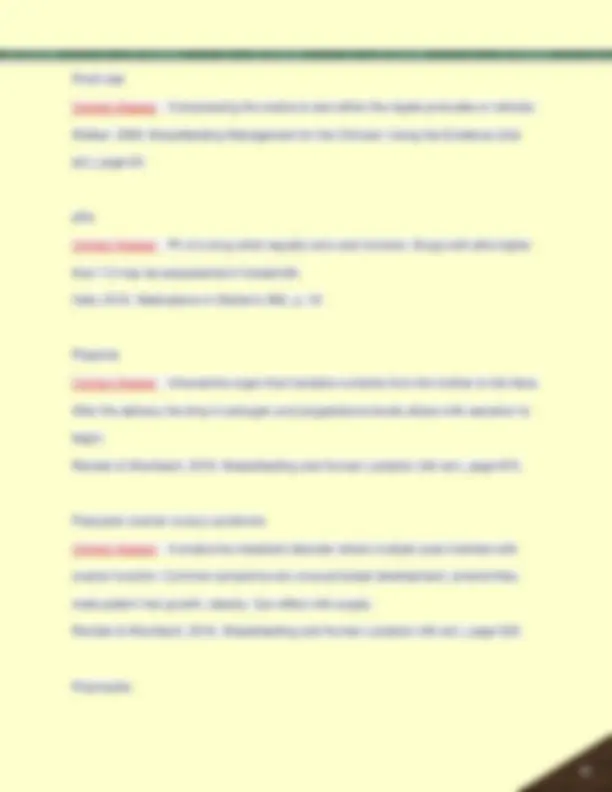
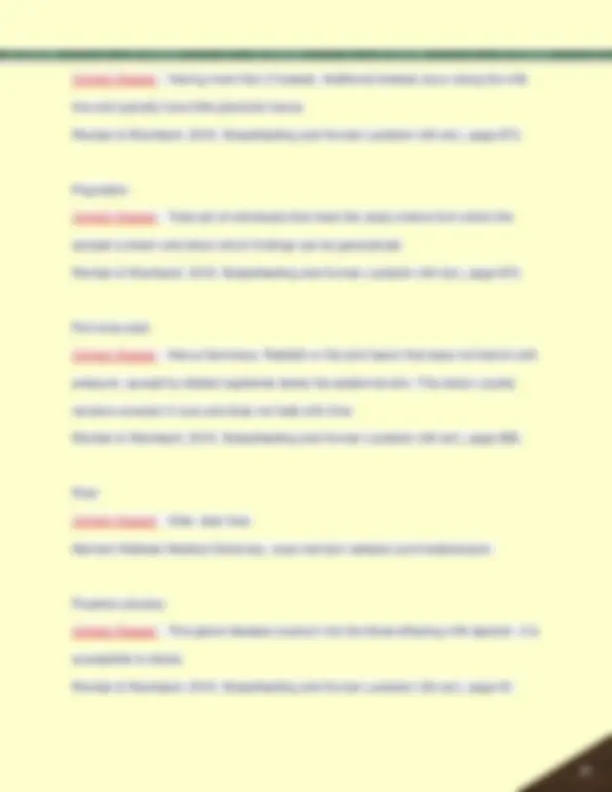

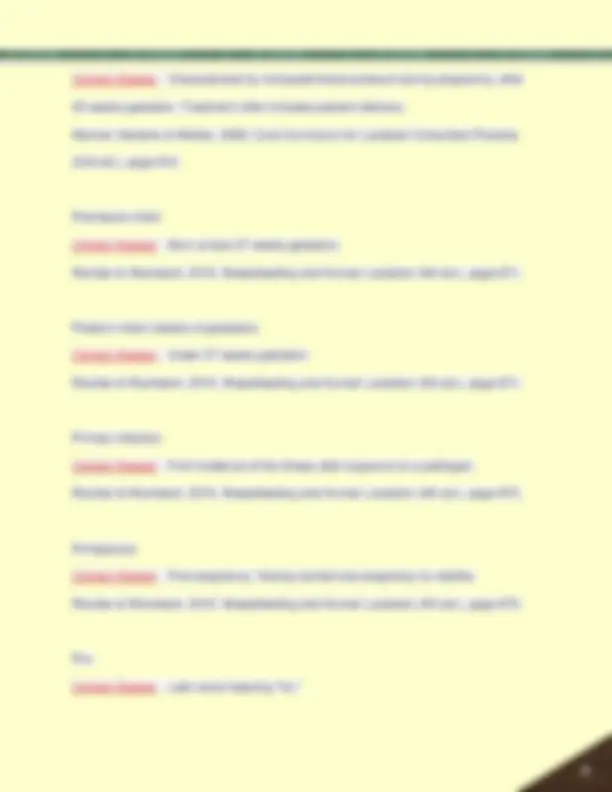
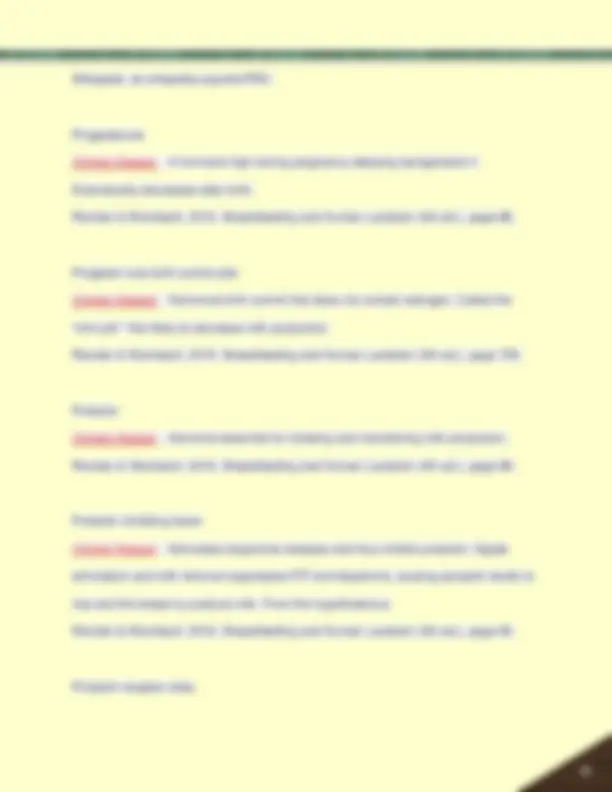
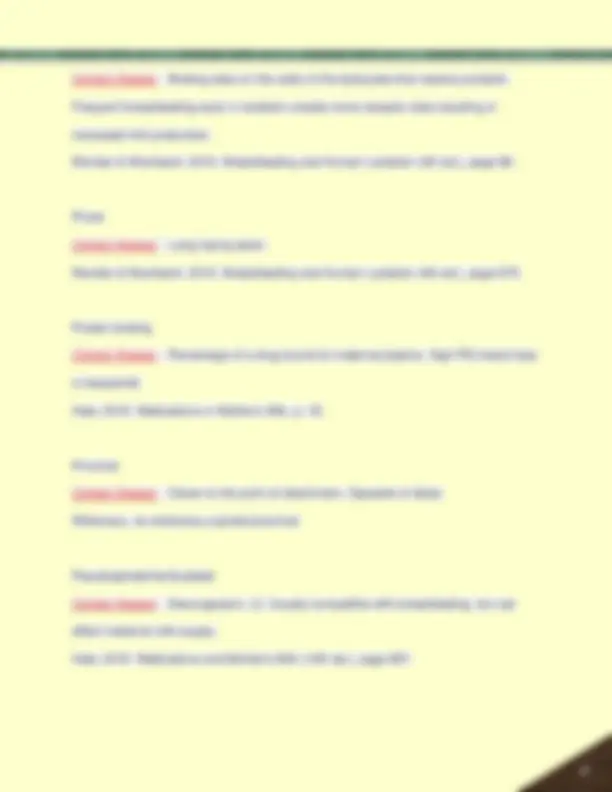
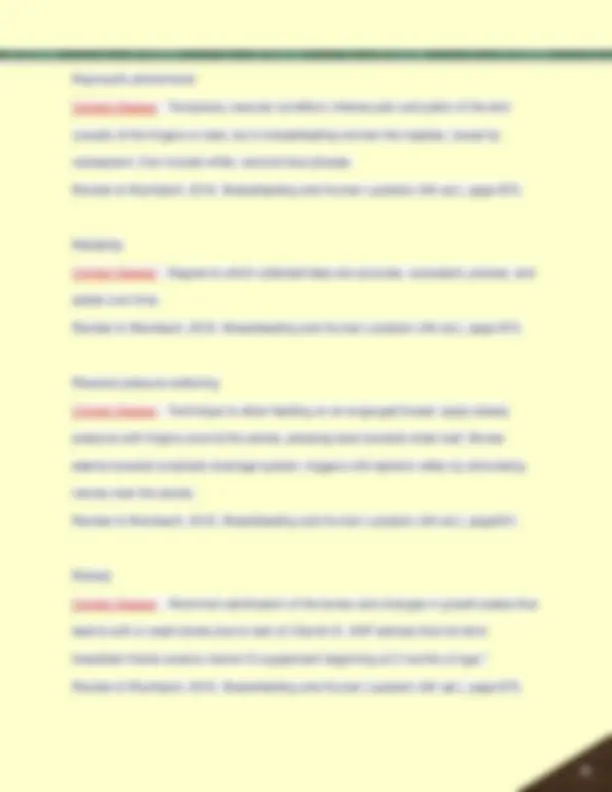
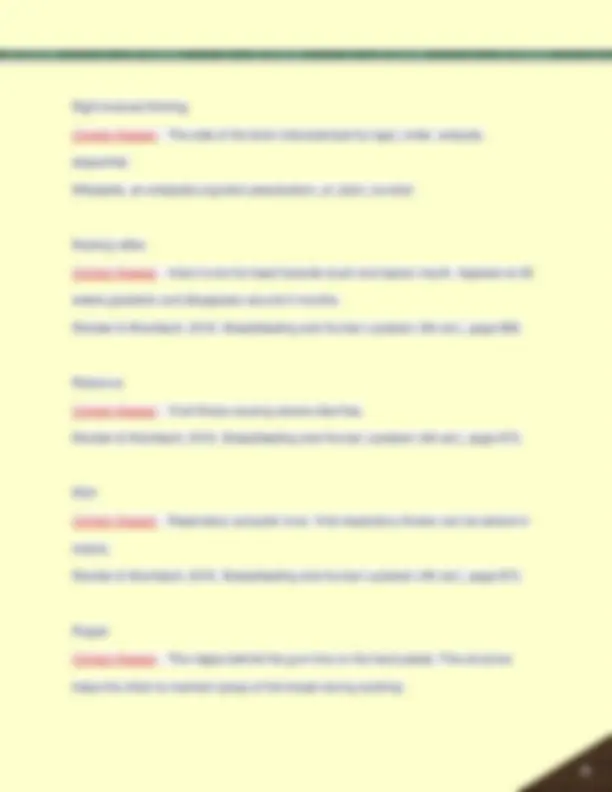
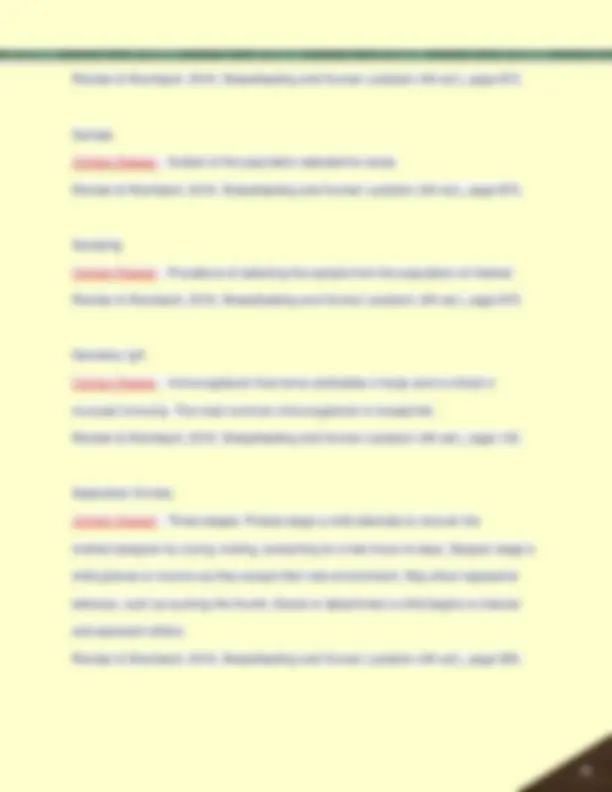
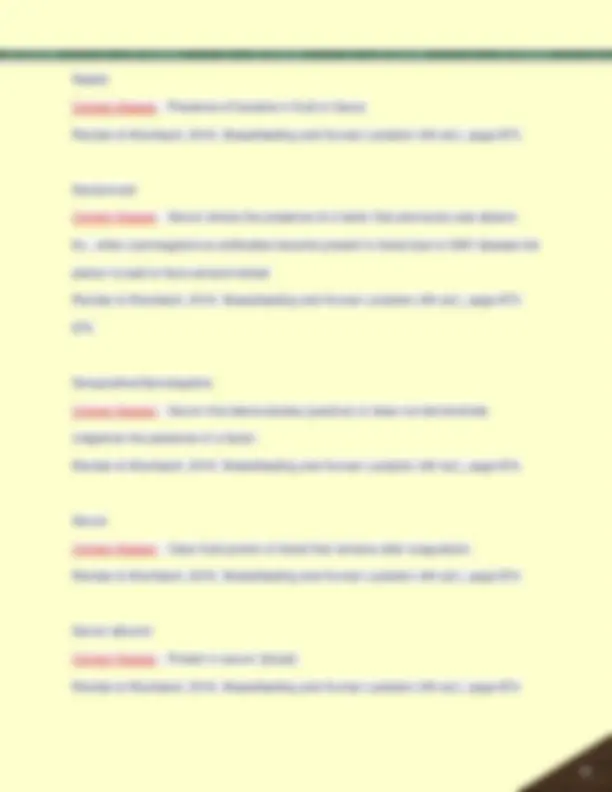
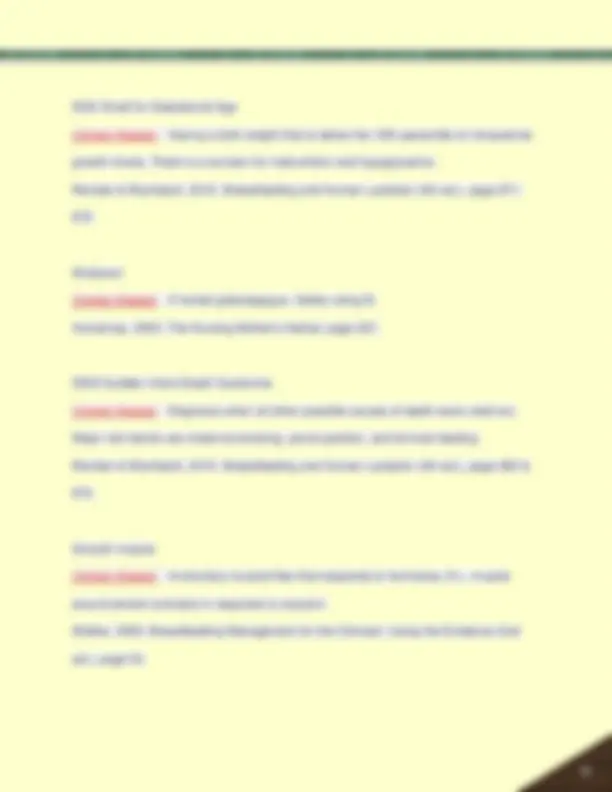
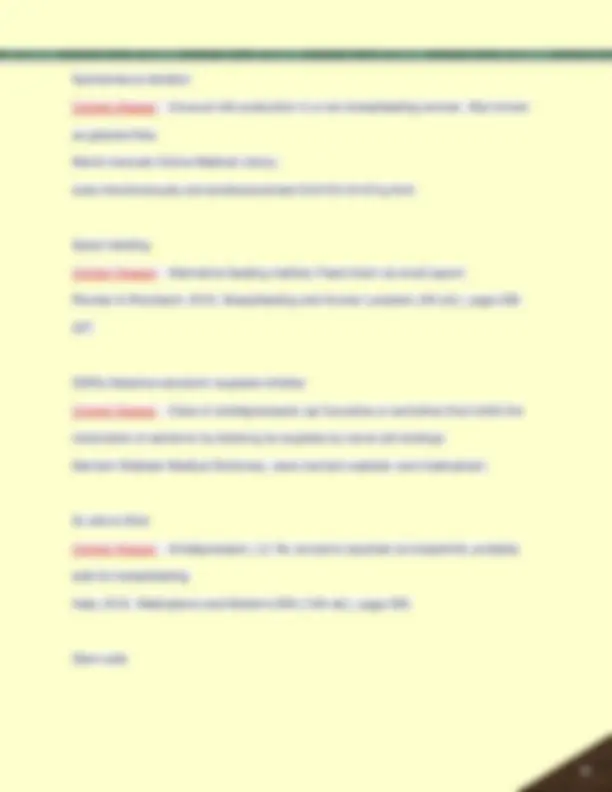
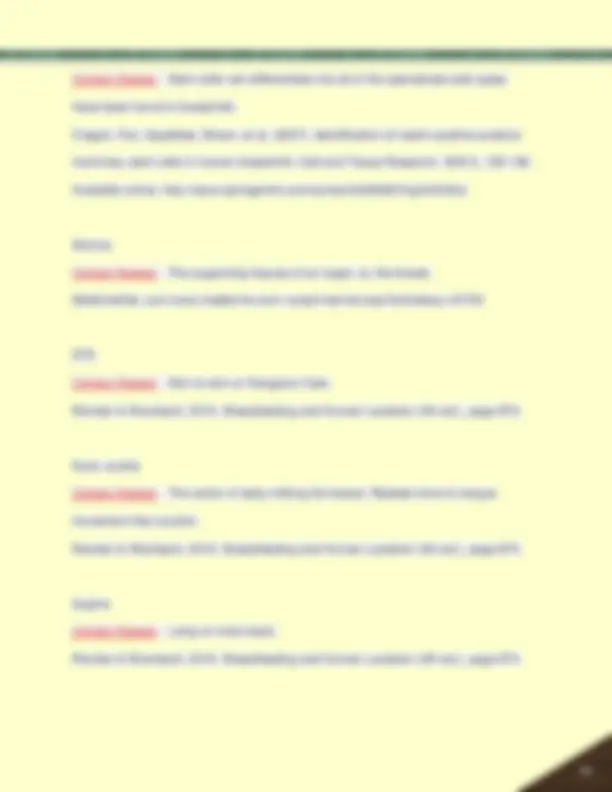
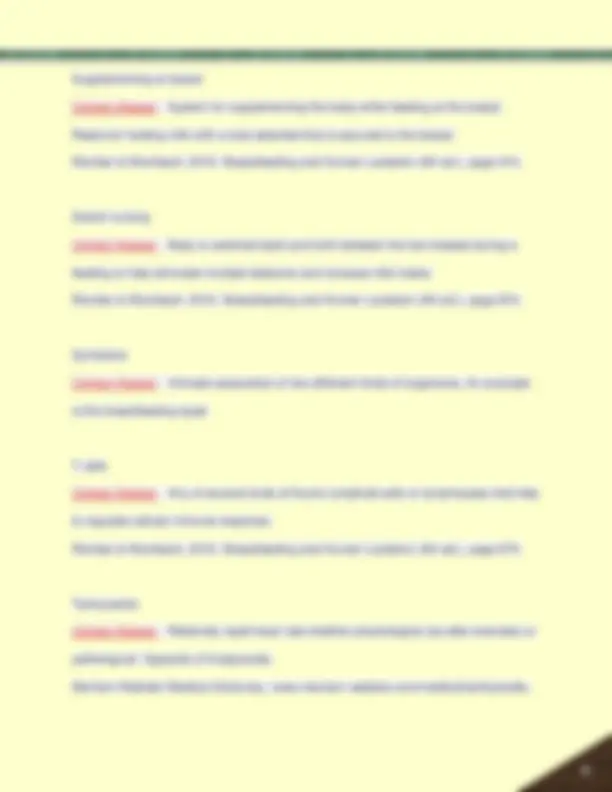
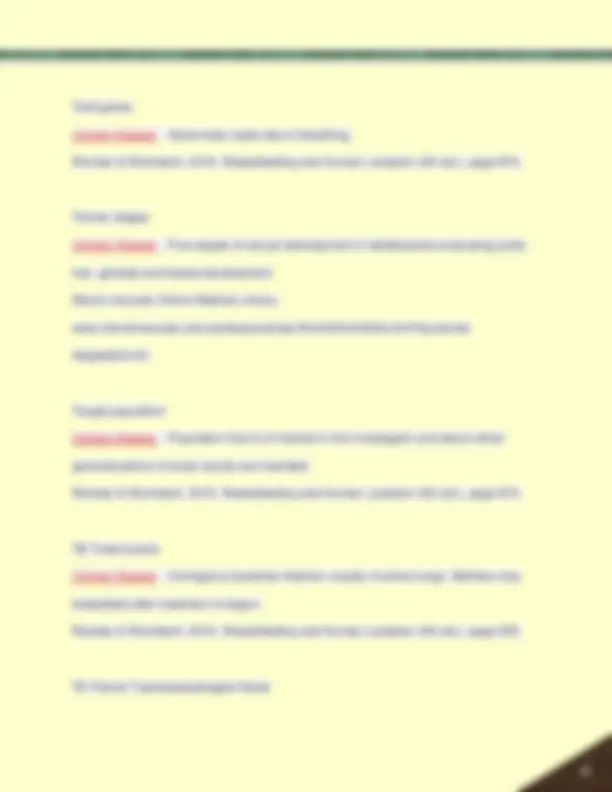
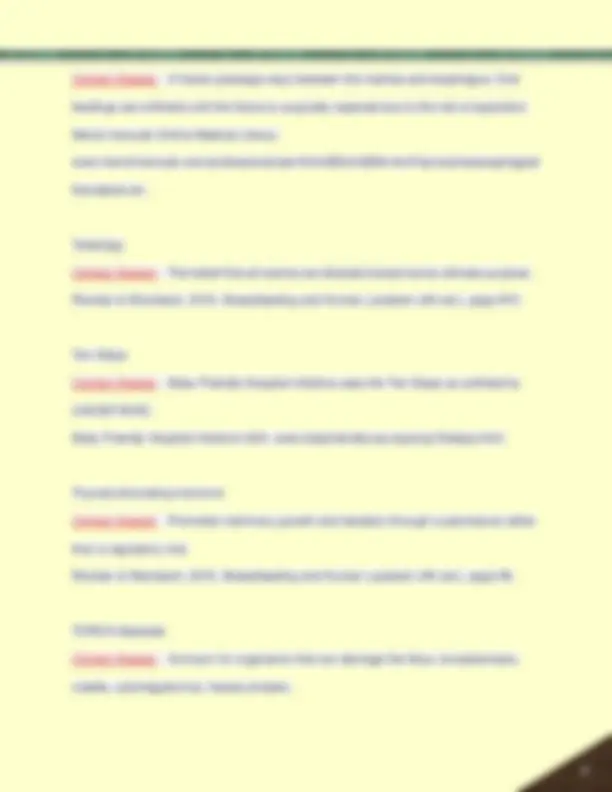
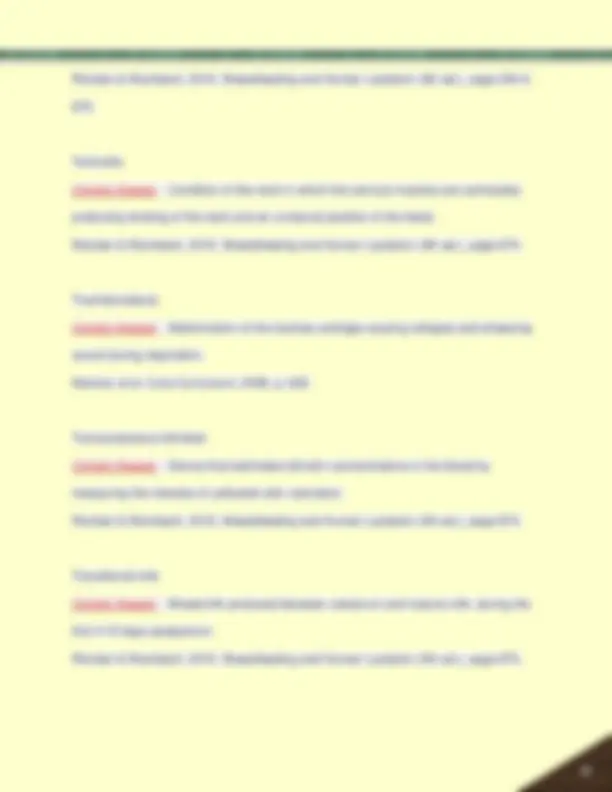
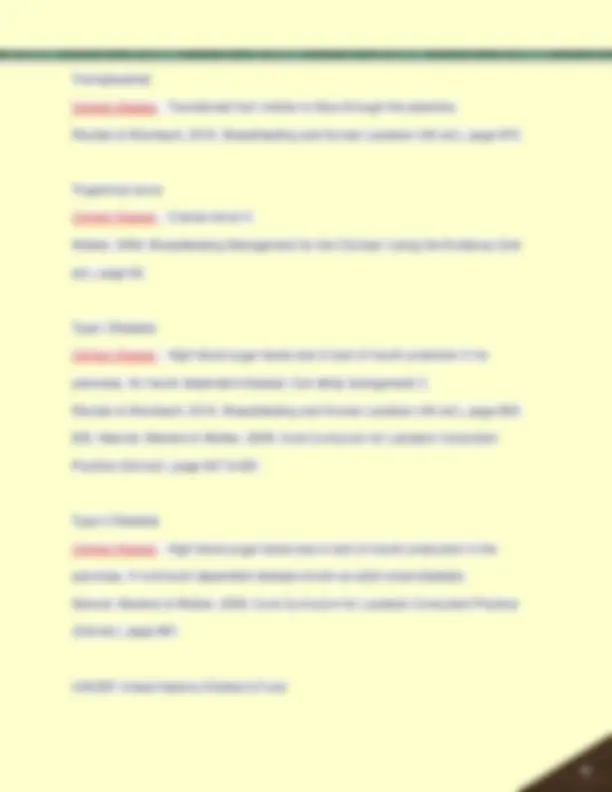
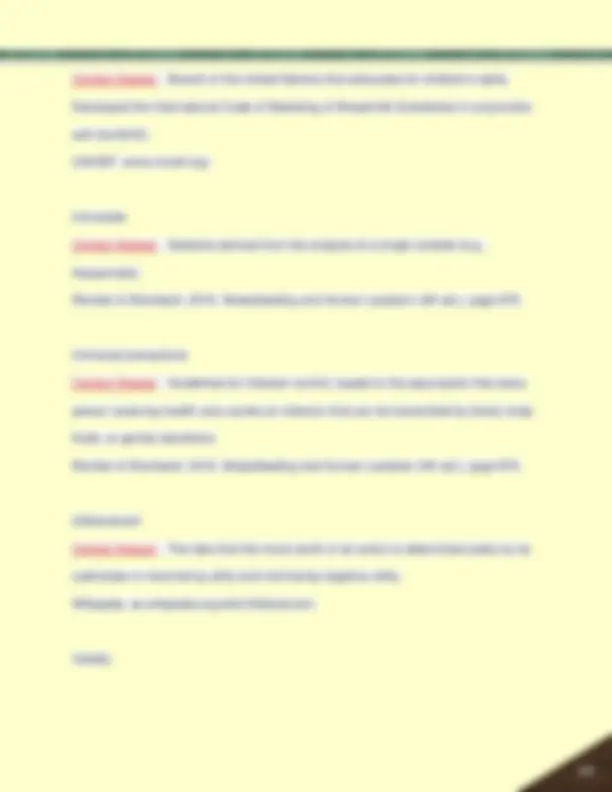


Study with the several resources on Docsity

Earn points by helping other students or get them with a premium plan


Prepare for your exams
Study with the several resources on Docsity

Earn points to download
Earn points by helping other students or get them with a premium plan
Community
Ask the community for help and clear up your study doubts
Discover the best universities in your country according to Docsity users
Free resources
Download our free guides on studying techniques, anxiety management strategies, and thesis advice from Docsity tutors
% of breastmilk that is carbohydrates Correct Answer: Approximately 7% Wikipedia. en.wikipedia.org/wiki/Breast_milk. % of breastmilk that is fat Correct Answer: Approximately 4% Hale and Hartman, 2007. Textbook of Human Lactation, page 50. % of breastmilk that is protein Correct Answer: Approximately .8 - 1 % Mannel, Martens & Walker, 2008. Core Curriculum for Lactation Consultant Practice (2nd ed.), page 272. % of calories in breastmilk from carbohydrates Correct Answer: Approximately 40% Hale and Hartman, 2007. Textbook of Human Lactation, page 69. % of calories in breastmilk from fat 2 Correct Answer: Approximately 50% Riordan & Wambach, 2010. Breastfeeding and Human Lactation (4th ed.), page 124. % of calories in breastmilk from protein Correct Answer: Approximately 10% Mannel, Martens & Walker, 2008. Core Curriculum for Lactation Consultant Practice (2nd ed.), page 272. Acinus Correct Answer: Any of the small sacs or alveoli that t
Typology: Exams
1 / 105

This page cannot be seen from the preview
Don't miss anything!





























































































% of breastmilk that is carbohydrates Correct Answer: Approximately 7% Wikipedia. en.wikipedia.org/wiki/Breast_milk. % of breastmilk that is fat Correct Answer: Approximately 4% Hale and Hartman, 2007. Textbook of Human Lactation, page 50. % of breastmilk that is protein Correct Answer: Approximately .8 - 1 % Mannel, Martens & Walker, 2008. Core Curriculum for Lactation Consultant Practice (2nd ed.), page 272. % of calories in breastmilk from carbohydrates Correct Answer: Approximately 40% Hale and Hartman, 2007. Textbook of Human Lactation, page 69. % of calories in breastmilk from fat
Correct Answer: Approximately 50% Riordan & Wambach, 2010. Breastfeeding and Human Lactation (4th ed.), page 124. % of calories in breastmilk from protein Correct Answer: Approximately 10% Mannel, Martens & Walker, 2008. Core Curriculum for Lactation Consultant Practice (2nd ed.), page 272. Acinus Correct Answer: Any of the small sacs or alveoli that terminate the ducts and are lined with secretory cells. Merriam-Webster Medical Dictionary. Available online: http://www.merriam- webster.com/medical/acinus?show=0&t= Acrocyanosis Correct Answer: Bluish discoloration of the hands and feet in the newborn; peripheral cyanosis. Should not persist beyond 24 hours after birth. Riordan & Wambach, 2010. Breastfeeding and Human Lactation (4th ed.), page 863. Active immunity Correct Answer: Immunity conferred by the production of antibodies by one's own immune system. Riordan & Wambach, 2010. Breastfeeding and Human Lactation (4th ed.), page 868.
Riordan & Wambach, 2010. Breastfeeding and Human Lactation (4th ed.), page 171 &
Aldomet/Methyldopa Correct Answer: Antihypertensive, L2. Frequently used to treat hypertension during pregnancy. No concerns reported via breastmilk. Hale, 2010. Medications and Mother's Milk (14th ed.), page 667. Allergen Correct Answer: A substance that causes an allergic response, such as foods, drugs, inhalants. Cow's milk is common source for infants. Riordan & Wambach, 2010. Breastfeeding and Human Lactation (4th ed.), page 863. Αlphalactalbumin Correct Answer: A major protein found in human milk whey. Assists in processing lactose. Riordan & Wambach, 2010. Breastfeeding and Human Lactation (4th ed.), page 863. Alveolar ridge Correct Answer: The ridges on the upper and lower jaw where infant's teeth will grow. Riordan & Wambach, 2010. Breastfeeding and Human Lactation (4th ed.), page 863. Alveolus, alveoli
Correct Answer: Secrete and store milk for let down. Surrounded by myoepithelial cells, contractile cells and connective tissue. Riordan & Wambach, 2010. Breastfeeding and Human Lactation (4th ed.), page 80. Amenorrhea Correct Answer: A natural phase of infertility that takes place when a mother is exclusively breastfeeding. Menstruation has not returned. Riordan & Wambach, 2010. Breastfeeding and Human Lactation (4th ed.), page 707 &865. Amoxicillin Correct Answer: Antibiotic, L2. Observe for change in intestinal flora, compatible. Riordan & Wambach, 2010. Breastfeeding and Human Lactation (4th ed.), page 177. Ampicillin Correct Answer: Antibiotic, L1. Observe for change in intestinal flora, compatible. Riordan & Wambach, 2010. Breastfeeding and Human Lactation (4th ed.), page 177. Anaphylaxis Correct Answer: Hypersensitivity (as to foreign proteins or drugs) resulting from sensitization following prior contact with the causative agent. Merriam-Webster Medical Dictionary. www.merriam-webster.com/medical/anaphylaxis.
Antigen Correct Answer: Substance that stimulates antibody production. May be dust, food, or bacteria. Riordan & Wambach, 2010. Breastfeeding and Human Lactation (4th ed.), page 863. Apgar score Correct Answer: Index to evaluate the condition of a newborn infant based on a rating of 0, 1, or 2 for color, heart rate, reflex response, muscle tone, and respiration with 10 being a perfect score. Merriam-Webster Medical Dictionary. www.merriam- webster.com/medical/apgar%20score. Apocrine gland Correct Answer: Sweat glands located on the areola that secrete a scent. Mannel, Martens & Walker, 2008. Core Curriculum for Lactation Consultant Practice (2nd ed.), page 197-198. Apoptosis Correct Answer: Programmed normal cell death. Riordan & Wambach, 2010. Breastfeeding and Human Lactation (4th ed.), page 863. Applied research
Correct Answer: Research that focuses on solving or finding an answer to a clinical or practical problem. Riordan & Wambach, 2010. Breastfeeding and Human Lactation (4th ed.), page 863. Areola Correct Answer: The darker pigmented skin that surrounds the nipple. Contains sebaceous glands (Montgomery Glands) Riordan & Wambach, 2010. Breastfeeding and Human Lactation (4th ed.), page 863. Aspirin Correct Answer: Salicylate analgesic, L3. Use associated with Reye's Syndrome in infants. Hale, 2010. Medications and Mother's Milk (14th ed.), page 87. Atopic eczema Correct Answer: Inherited allergic tendency to skin rashes or inflammation. Exclusively breastfed infants are less likely to develop as cow's milk protein is a common allergen. Riordan & Wambach, 2010. Breastfeeding and Human Lactation (4th ed.), page 863. Autocrine control Correct Answer: The point in lactation when milk supply is controlled by milk removal. Local control in the breast. Riordan & Wambach, 2010. Breastfeeding and Human Lactation (4th ed.), page 92.
Correct Answer: Major protein in bovine milk. Hale & Hartman, 2007. Textbook of Human Lactation, page 40. Back to sleep Correct Answer: A campaign that significantly reduced SIDS. Babies are less prone to SIDS when sleeping on their back. Mannel, Martens & Walker, 2008. Core Curriculum for Lactation Consultant Practice (2nd ed.), page 632. Bactericidal Correct Answer: Destroys bacteria. Merriam-Webster Medical Dictionary. www.merriam-webster.com/medical/bactericidal. Bacteriostatic Correct Answer: Prevents the growth of bacteria. Riordan & Wambach, 2010. Breastfeeding and Human Lactation (4th ed.), page 864. Bactrim/Septra Correct Answer: Sulfonamide antibiotic, L3. The mixture of trimethoprim and sulfamethoxazole. No concerns reported via breastmilk. Hale, 2010. Medications and Mother's Milk (14th ed.), page 249. BALT/GALT/MALT
Correct Answer: Bronchus/gut/mammary-associated immunocompetent lymphoid tissue. Intermammary pathway. IgA antibodies are transferred through breastmilk to the infant. Riordan & Wambach, 2010. Breastfeeding and Human Lactation (4th ed.), page 864. Basic research Correct Answer: Research that generates knowledge for the sake of knowledge. Riordan & Wambach, 2010. Breastfeeding and Human Lactation (4th ed.), page 864. Bed-sharing Correct Answer: Sharing adult bed with baby. Questioned safety in reduction of SIDS. Safe bed sharing has been shown to extend the duration of breastfeeding. Riordan & Wambach, 2010. Breastfeeding and Human Lactation (4th ed.), page 282-
Bellagio Consensus Conference Correct Answer: Meeting to develop protocol for the Lactational Amenorrhea Method of birth control. 1988. Riordan & Wambach, 2010. Breastfeeding and Human Lactation (4th ed.), page 714-
Beneficence Correct Answer: The duty to do good.
Blessed thistle Correct Answer: An herbal galactagogue. L3. Walker, 2009. Breastfeeding Management for the Clinician: Using the Evidence (2nd ed.), page 592. Bolus Correct Answer: A quantity of medication given by IV, or a quantity of fluid (milk) given orally. Merriam-Webster Medical Dictionary. www.merriam-webster.com/medical/bolus. Bradycardia Correct Answer: Relatively slow heart rate. Opposite of tachycardia. Merriam Webster Medical Dictionary. www.merriam-webster.com/medical/bradycardia. Breastfeeding dyad Correct Answer: A breastfeeding mother and baby. Buccal pads Correct Answer: Fat pads on the masseter muscles in an infant's cheeks giving them a plump cheeked appearance. Provide stability for the tongue during suckling. Riordan & Wambach, 2010. Breastfeeding and Human Lactation (4th ed.), page 864. Calories in breastmilk
Correct Answer: Mature milk has approximately 20 cal/oz. Mannel, Martens & Walker, 2008. Core Curriculum for Lactation Consultant Practice (2nd ed.), page 227. Candidiasis Correct Answer: Fungal infection caused by Candida albicans; also called "thrush." Riordan & Wambach, 2010. Breastfeeding and Human Lactation (4th ed.), page 864. Caput succedaneum Correct Answer: Diffuse swelling or collection of serum under the scalp of the newborn from birth trauma. Differentiated from cephalhematoma by unrestriction by the sutures of the skull. Riordan & Wambach, 2010. Breastfeeding and Human Lactation (4th ed.), page 864. Casein Correct Answer: The main protein in breastmilk. Creates the curd when digested in the infant stomach. Riordan & Wambach, 2010. Breastfeeding and Human Lactation (4th ed.), page 864. Walker, 2009. Breastfeeding Management for the Clinician: Using the Evidence (2nd ed.), page 26. Central pedicle technique Correct Answer: Breast reduction surgical technique. Intended to keep ducts intact.
Chi-square Correct Answer: Statistical procedure that uses nominal level data and determines significant differences between observed frequencies in relation to data and expected frequencies. Riordan & Wambach, 2010. Breastfeeding and Human Lactation (4th ed.), page 864. Choanal atresia Correct Answer: A rare congenital anomaly, blocked posterior nostrils on one or both sides. Feedings by mouth are either difficult or impossible. Surgery opens the airways. Riordan & Wambach, 2010. Breastfeeding and Human Lactation (4th ed.), page 644. Chylothorax Correct Answer: Congenital anomaly, obstruction of the lymphatic system. Chyle (lymphatic fluid) collects in the chest cavity and is drained via chest tubes. Managed by diet and medication. Fat free breastmilk has been used successfully. Riordan & Wambach, 2010. Breastfeeding and Human Lactation (4th ed.), page 648-
Ciprofloxacin (Cipro) Correct Answer: Antibiotic, L3. Recently approved by AAP. Riordan & Wambach, 2010. Breastfeeding and Human Lactation (4th ed.), page 178. Hale, 2010, Medications in Mothers' Milk. p. 224.
Claritin/Loratadine Correct Answer: Long-acting antihistamine, L1. Observe for sedation, dry mouth, and tachycardia. Hale, 2010. Medications and Mother's Milk (14th ed.), page 617. CMV Cytomegalovirus Correct Answer: Type of herpes virus found in human milk, genital tract, urine, and pharynx. Transmitted by close contact. Avoid pumping or breastfeeding in premature infants if mom has acute infection. Riordan & Wambach, 2010. Breastfeeding and Human Lactation (4th ed.), page 204. Colic Correct Answer: Syndrome in early infancy characterized by episodic loud crying, apparent abdominal pain (legs drawn up and rigid abdomen) and irritability. Riordan & Wambach, 2010. Breastfeeding and Human Lactation (4th ed.), page 864-
Colostrum Correct Answer: First milk created during late pregnancy and early postpartum period. Has higher concentrations of immunoglobins, fat soluble vitamins and some minerals. Riordan & Wambach, 2010. Breastfeeding and Human Lactation (4th ed.), page 865.
Riordan & Wambach, 2010. Breastfeeding and Human Lactation (4th ed.), page 865. Contraception Correct Answer: Preventing conception. Hormonal pill, barrier methods, intrauterine device. Breastfeeding can provide contraceptive protection. Riordan & Wambach, 2010. Breastfeeding and Human Lactation (4th ed.), page 865. Cooper's ligaments Correct Answer: Also know as the "suspensory ligaments." Attaches the skin of the breast to the chest wall. Riordan & Wambach, 2010. Breastfeeding and Human Lactation (4th ed.), page 82. Cord blood Correct Answer: Blood remaining in the umbilical cord after birth. May be saved for later stem cell transplantation. Riordan & Wambach, 2010. Breastfeeding and Human Lactation (4th ed.), page 865. Correlation coefficient Correct Answer: Statistic that indicates the degree of relationship between two variables. The range in value is +1.00 to - 1.00; 0.0 indicates no relationship, +1.00 is a perfect positive relationship, and - 1.00 is a perfect inverse relationship. Riordan & Wambach, 2010. Breastfeeding and Human Lactation (4th ed.), page 865.
Creamotcrit Correct Answer: The amount of cream in a milk sample. The amount of cream (fat) varies from mother to mother, feeding to feeding, and throughout the course of lactation. Riordan & Wambach, 2010. Breastfeeding and Human Lactation (4th ed.), page 865. Cross-nursing Correct Answer: Informal, short term wet nursing. Typically seen in the context of child care. Riordan & Wambach, 2010. Breastfeeding and Human Lactation (4th ed.), page 865. Cultural competency Correct Answer: Ability to understand, communicate, and interact effectively with people from different cultures. Four components: Awareness of one's own cultural worldview; attitude towards cultural differences; knowledge of different cultural practices and worldviews; cross-cultural skills. Wikipedia. en.wikipedia.org/wiki/Cultural_Competency. Cultural relativism Correct Answer: Acknowledging the variation in beliefs and actions given to the behaviors of different cultures. Riordan & Wambach, 2010. Breastfeeding and Human Lactation (4th ed.), page 865. Culture